
Prototypes
Series-A
⚜️ Chronos-T4: Spacetime Field Disruptor Defense System
The Chronos-T4 Defense System is a big step forward, using controlled spacetime metrics to prevent high-speed threats by messing with their chronometric timing. Chronos-T4 disables incoming projectiles by applying localized time changes that cause the projectiles to become very stressed. The platform uses metric solutions created by Alcubierre which are generated using quantum vacuum polarization. The curvature of local spacetime is held in place by continuous Casimir energy focusing which Tesla-class superconducting toroidal fields enable. They maintain persistent temporal differences by adjusting the vacuum state to interact with a designed Compton wavelength cavity. The main method of neutralization results in different proper time vectors throughout the target. At Mach 15, when a tungsten-carbide hypersonic glide vehicle is used, the system forms a temporal shear field. The leading edge advances through time approximately 10⁻⁷ times more slowly than the trailing edge. Because of this, the internal stress tensors go over 8 GPa which is twice the material's ultimate tensile strength, resulting in the nanocrystalline lattice breaking within microseconds. When a vehicle's quantum-enhanced gyroscopes are subjected to relativistic strain, they show phase decoherence.
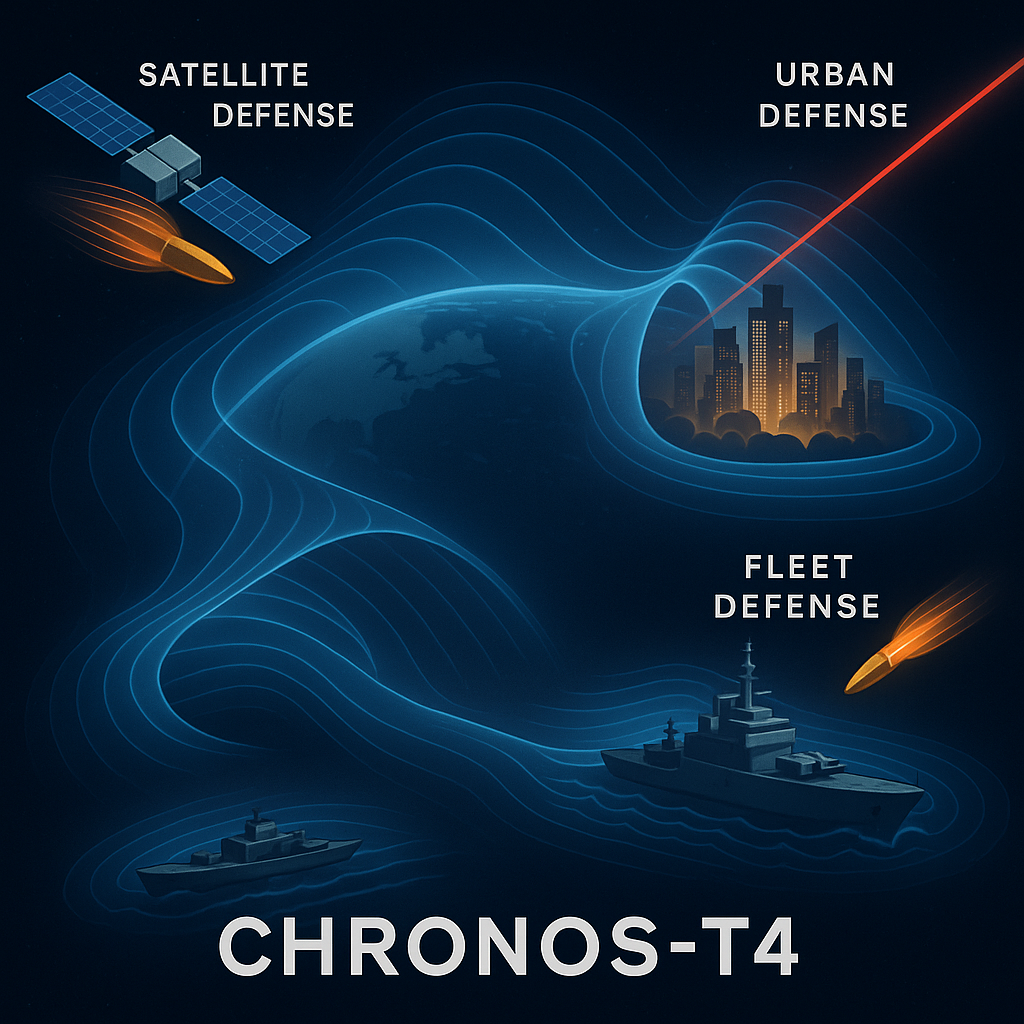
A drift of >10⁻³ rad/ms in navigation systems can result in terminal guidance failure within milliseconds. The system works with a quantum neural network (Q-PINN) of 256 entangled qubits, together with an entangled photon interferometry array that can reconstruct geodesic fields at attosecond resolution and 10¹⁵ operations per second. A quantum-enhanced LIDAR array is used for threat detection, sending out ~10²⁰ photons every second at 1500 nm which provides sub-centimeter accuracy and time accuracy at the femtosecond level. The field generation system relies on 48 niobium-tin superconducting toroids, each with a radius of one meter and filled with 10¹⁸ carbon nanotube quantum dots per cm³, to quickly and reliably start the field with a 250 MJ capacitive discharge bank. A tokamak fusion reactor with a compact design delivers 300 MW of thermal power and superfluid helium-3 cooling systems are used to maintain quantum coherence at 0.5 K. Chronos-T4 is designed to work up to 2,000 km away and needs only 0.25 milliseconds to engage, depending on how fast the feedback travels. The system uses about 20 MJ of energy to address more than 80 different threats during each cycle. The temporal field is stable enough to guarantee that δ(Δt/Δx) is less than 10⁻⁹ s/m within a centimeter-level envelope and the maximum time each cycle lasts is about 8 seconds. The devices are designed to operate at temperatures up to 320 K, withstand vibrations of up to 15g RMS and resist radiation higher than 10⁸ rad(Si). The Chronos-T4 system is the result of over a century of quantum field theory work, bringing advanced defense abilities that remain within known physical limits. The following phase will concentrate on making the system more energy efficient and smaller so it can be used in the field and by many different organizations.
(*) The strategic game-change provided by this weapon enables a «First-strike advantage elimination, with no nuclear offensive capacity». It establishes «A zero-sum nuclear equilibrium for WW3 and for humanity».
⚜️ Michael-A: Relativistic Kinetic Interceptor (RKI)
The Michael-A system is designed to stop hypersonic missiles, orbital bombardment and ultrahigh-speed projectiles by neutralizing them. The system relies on projectiles made from tungsten or depleted uranium that weigh between 1 and 10 kilograms and move at 0.3 times the speed of light. The interceptor works solely with kinetic energy, so it does not need explosives to destroy targets at unmatched speed and accuracy. The main strength of the Michael-A is its antimatter-powered propulsion system which causes nuclear fusion reactions. To fire the device, tiny amounts of antiprotons are injected into pellets containing deuterium and tritium. The reaction between matter and antimatter creates a plasma jet through fusion, while releasing very high energy and temperatures. The magnetic system holds the projectile in a jet shape and then accelerates it through a nozzle to reach high speeds. Only about 10% of the 90 gigajoules from a single microgram of antimatter is converted into thrust power. A 1-kilogram projectile needs 500 micrograms of antimatter to reach 0.1c, but the energy required rises a lot as the projectile's size or speed increases. The Michael-A system can use quantum radar to monitor dangers from thousands of kilometers in both atmospheric space and low Earth orbit. With quantum illumination, soldiers can locate rapidly moving hidden or obscured targets with great accuracy, even when the environment is noisy. The radar feeds data to the artificial intelligence system, allowing it to process sensor information at a speed of petabytes per second. With target trajectory prediction, the AI system can find interception solutions with less than one meter accuracy over 10,000 kilometers, even when the target is moving at 0.2c. The AI system fires a projectile using its calculated best parameters within just one millisecond, so the target is intercepted before it can avoid the shot. If a Mach 20 hypersonic missile is detected at 5,000 kilometers by quantum radar and AI, the system responds in milliseconds. The Michael-A system sends a 1-kilogram projectile flying at 0.3c. The projectile reaches its target only milliseconds after being launched and releases 9 × 10¹⁵ joules of energy, which is the equivalent of more than two kilotons of TNT in a fast plasma discharge that destroys the target in microseconds.
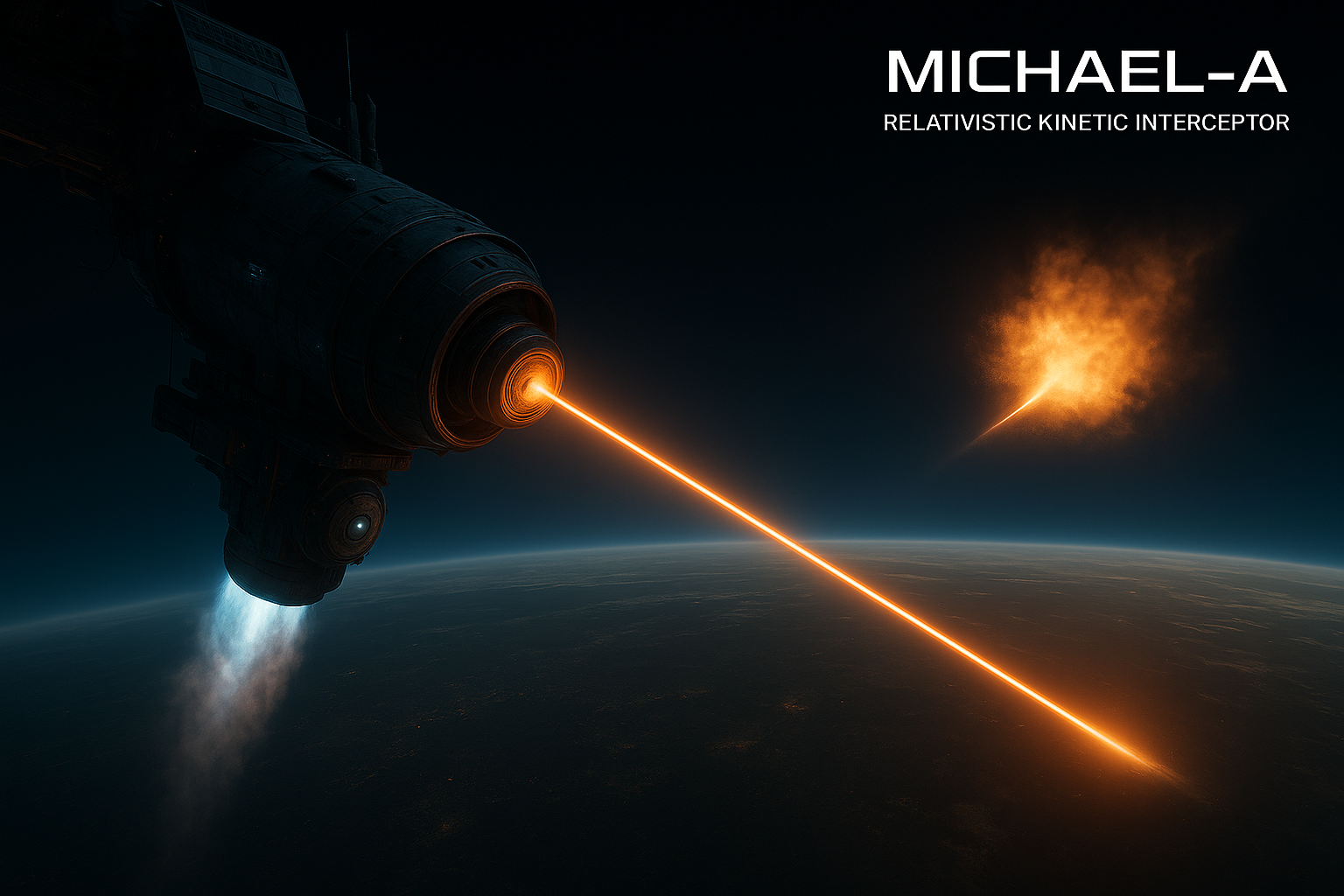
Michael-A missiles can work over greater ranges and faster than THAAD or railguns since they are not limited by the air or by sub-relativistic speeds. The Michael-A projectile destroys targets by moving fast and transferring its energy, without needing a laser system to control the beam's direction or worry about overheating. The system does not need guidance systems on projectiles since the interceptor is guided by precision and the effects of relativistic inertia. Even so, putting this technology into practice is extremely challenging. At present, only a few scientists manage to produce less than one nanogram of antimatter annually which means new technology is needed to enhance both the amount made and how it is stored safely. To prevent the projectile from being damaged or deflected, earth-based launches of relativistic projectiles must overcome atmospheric drag. Two ideas have been put forward by scientists to start space launches from near-space: using magnetic plasma sheaths and high-altitude platforms. Since the current computing systems do not perform well enough, scientists are looking into new models for artificial brains such as neuromorphic systems and synaptic processors, that work at similar speeds as human neural circuits. Quantum-linked telemetry provides the accuracy needed for interceptor and command systems to work together effectively.
⚜️ OLYMPUS-II: Morpho Cloud Defense System
The Olympus-II Morpho Cloud Defense System functions as a high-fidelity multi-domain protective architecture, which delivers uninterrupted smart defense capabilities against objects moving at high velocity and directed energy attacks, stealth breaches and low-observable swarm networks. The operational center of Olympus-II consists of the Morphocloud, which functions as an active barrier through its nanoscale metamaterials dispersed across a 3,000-meter radius at densities ranging around 1000 particles per cubic meter based on threat conditions. Each nanometric particle reaches 150 nanometers across and its photonic magnetic acoustic actuators enable quick phase-state changes within milliseconds. The Morphocloud establishes its protective dome within seconds after deployment, through electromagnetic projection arrays or micro-canister dispersal units at launch velocities between 60 to 120 m/s under calm atmospheric conditions. The electromagnetic confinement fields enable morphogenetic lattice control, which allows the cloud to generate elastic hardpoints with adjustable stiffness values ranging around 100 Pa. This capability enables the cloud to achieve protective strength equivalent to polycarbonate at lower settings or advanced composites at higher settings. The quantum entangled radar array operates from distances exceeding 1,000 kilometers to detect threats through its millimeter-wave detection capability by tracking small cross-sectional radar signatures smaller than 0.01 m². The system protects signal coherence by using superconducting detectors with noise floors under 10 Kelvin that stay stable during atmospheric and space operations. Olympus-II activates plasma lensing fields through phase-locked terahertz radiation bursts which are generated remotely to defend against threats. The ionization of atmospheric nitrogen and oxygen elements creates these fields, which spread through a 1.5-meter diameter focal cone that extends up to 200 meters in length. The plasma reaches temperatures between 8,000 and 15,000K, while maintaining local charge densities at about 1000 electrons per cubic centimeter, which enables 10 MW continuous-wave laser beam absorption or diffraction within milliseconds of contact.
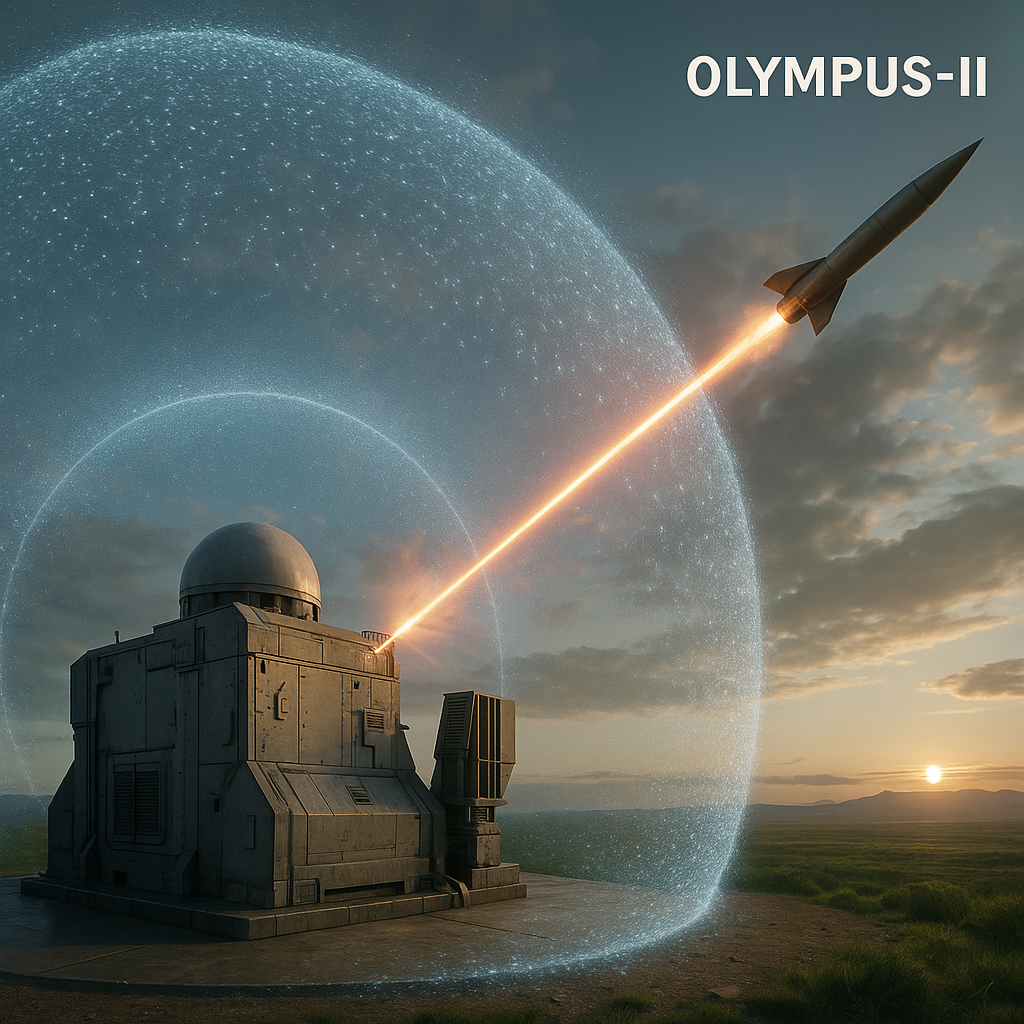
The lens coherence depends on magnetic confinement fields, which are tuned through rapidly reconfigurable micro-toroidal field coils embedded in emitter modules while these coils consume peak pulse currents not exceeding 400 A during each lens cycle that lasts no more than msec. The distributed artificial intelligence mesh exists as a control framework made up of neuromorphic processors, which operate at 10⁷ synaptic updates per second and use energy less than 0.2 nJ per operation. Decision latency across the entire network averages milliseconds-level speed for high-priority intercept paths with Quadratic Unconstrained Binary Optimization (QUBO-QA). The pre-training of machine learning models occurs through synthetic threat libraries including more than 40 million engagements before they adapt their reinforcement learning functionality to detect new attack signatures, using short-term episodic memory layers. A nanostructural self-repair system maintains both structural integrity and resilience of Morphocloud. The material matrix transmits high-frequency vibrational pulses at 100–250 kHz to embedded piezoelectric actuators that create capillary-like attraction forces which self-assemble particles in damaged areas back to formation within msec for 0.5 m² and smaller regions. The power system of Olympus-II operates through compact fusion cores, which use deuterium-tritium reaction cycles confined by magnetic inertial methods. The units generate 15 MW of thermal output, which thermophotovoltaic converters convert to electrical power at 60% efficiency resulting in 9 MW of net electrical output. The system enables the operation of Morphocloud maintenance at 2.5 MW, while generating plasma lenses at 4 MW peak power and powering AI system operations at less than 200 kW. The defensive perimeter of Olympus-II extends to 6 × 10⁷ cubic meters in a spherical or hemispherical formation, while its threat intercept times it is calculated to range from 0.5 to 3 seconds, based on the speed of incoming targets between 2,000–4,500 m/s. The system must be tested simulating multiple threats with beams and swarm attacks, to achieve a minimum 97% success rate of defense operations within a 3-second period through 10,000 experimental scenarios. The Olympus-II system functions across various hardware sizes that range from destroyer and orbital defense base platforms down to ground-based protective capabilities for bases or critical infrastructure points. The physical dimensions of the system extend from 12 m² for the AI and power core housing to 100 m² which includes all auxiliary projection and lens-generation hardware. The complete system has to operate through modular components, which meet both MIL-STD-882-E safety standards and ISO/IEC 27040 requirements for cyber-physical systems.
⚜️ QISA: Quantum Isomeric Security Array
The Quantum Isomeric Security Array (QISA) introduces a new way of thinking about sensor security, using relativistic quantum encoding and nuclear isomeric entropy. Because quantum sensors are now vulnerable to advanced attacks, QISA aims to ensure a security system is truly tamper-proof, low-power and cannot be cloned. The use of Pu-241 nuclear isomers is central to QISA, as their special electron-nuclear interactions help the system produce high-dimensional quantum signatures. The security model of QISA relies on these signatures which come from metastable nuclear states and are affected by electron behavior at high speeds. Unlike traditional cryptographic fingerprints or quantum sensors using NV-center diamonds, QISA's output is secure and cannot be copied, spoofed or disabled by anyone, not even by attackers with quantum capabilities. It is thanks to a number of important innovations that this is possible. First, the isomeric quantum entropy source relies on the unpredictable nature of Pu-241 metastable states to produce entropy at the subatomic level. Every QISA unit is built with an entropy profile that is unique to its material and changes over time. In addition, the relativistic effect makes the phenomenon even more unique. In plutonium and similar high-Z elements, the orbitals of electrons are distorted by relativity which subtly changes the spectrum and reveals both the isotope and its microstructure. These new quantum states, adjusted using relativity, are strong identity markers that cannot be made or copied artificially and are almost impossible to reproduce even with the same nuclear materials.
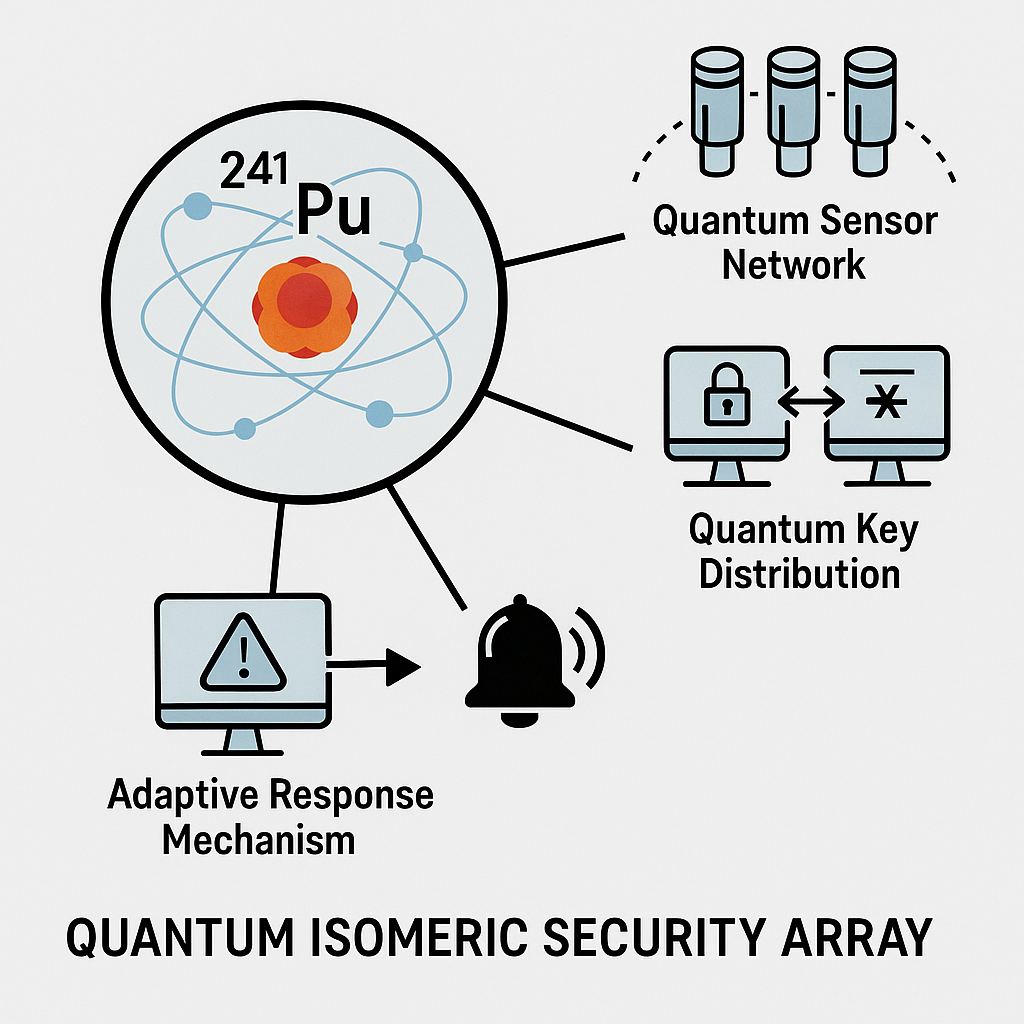
Another innovation is that QISA can function in places where there is no power for active surveillance. Because the system relies on nuclear isomeric transitions and the inherent encoding of materials, it can rest without using any external energy. Because of this, QISA is well-suited for use in stealth deployments, sensor networks that work unattended or long-term monitoring of infrastructure in dangerous or remote areas. QISA is designed to fit well into quantum-secured communication systems, using QKD to make sure that every authenticated message is protected from being intercepted or falsified by cryptographic protocols. Because of its cryptographic foundation, QISA can both protect its own output and join in on quantum communication systems, where it acts as both a sensor and a secure endpoint. All these features combine to make QISA a breakthrough in secure sensor architecture, using the unchanging laws of nuclear and relativistic quantum physics to ensure the system is physically safe, can handle any environment and uses less energy. Because it is used in defense and critical infrastructure, QISA is set to change the way we think about security as quantum threats continue to grow.
⚜️ Phaos-II: Quantum Photodisintegration Array (QPA)
The Phaos-II system is a conceptual next-generation non-kinetic defense platform based on principles of nuclear photonics and advanced quantum sensing. It integrates three primary subsystems: (a) nuclear isomer excitation modules, (b) adaptive gamma-ray optics, and (c) quantum radar-based targeting, to enable the potential neutralization of high-speed threats at distances up to 500 kilometers within seconds. The system architecture is informed by emerging experimental research and cross-disciplinary advances in high-intensity laser physics, quantum metrology, and directed energy systems. Preliminary theoretical studies suggest that nuclear isomer excitation, specifically involving tantalum-180m (Ta-180m), may be enhanced using extreme light sources. Proposed configurations involve the use of ultra-intense (10-petawatt class) laser pulses at 1 Hz repetition rates to induce photonuclear transitions, hypothetically yielding high-purity gamma radiation at 3 MeV (ΔE/E < 10⁻⁴). Though no experimental demonstration of large-scale energy release from isomeric states has yet been achieved, this forms the conceptual basis for further research into controlled nuclear de-excitation mechanisms. To maintain beam coherence and focus over long distances, laser-plasma waveguide simulations indicate the potential to sustain beam divergence below 1 milliradianunder atmospheric transmission conditions. Gamma-ray propagation at energies around 2 MeV could, under ideal circumstances, remain effective over 10-kilometer scales, assuming optimized collimation and minimal environmental interference.
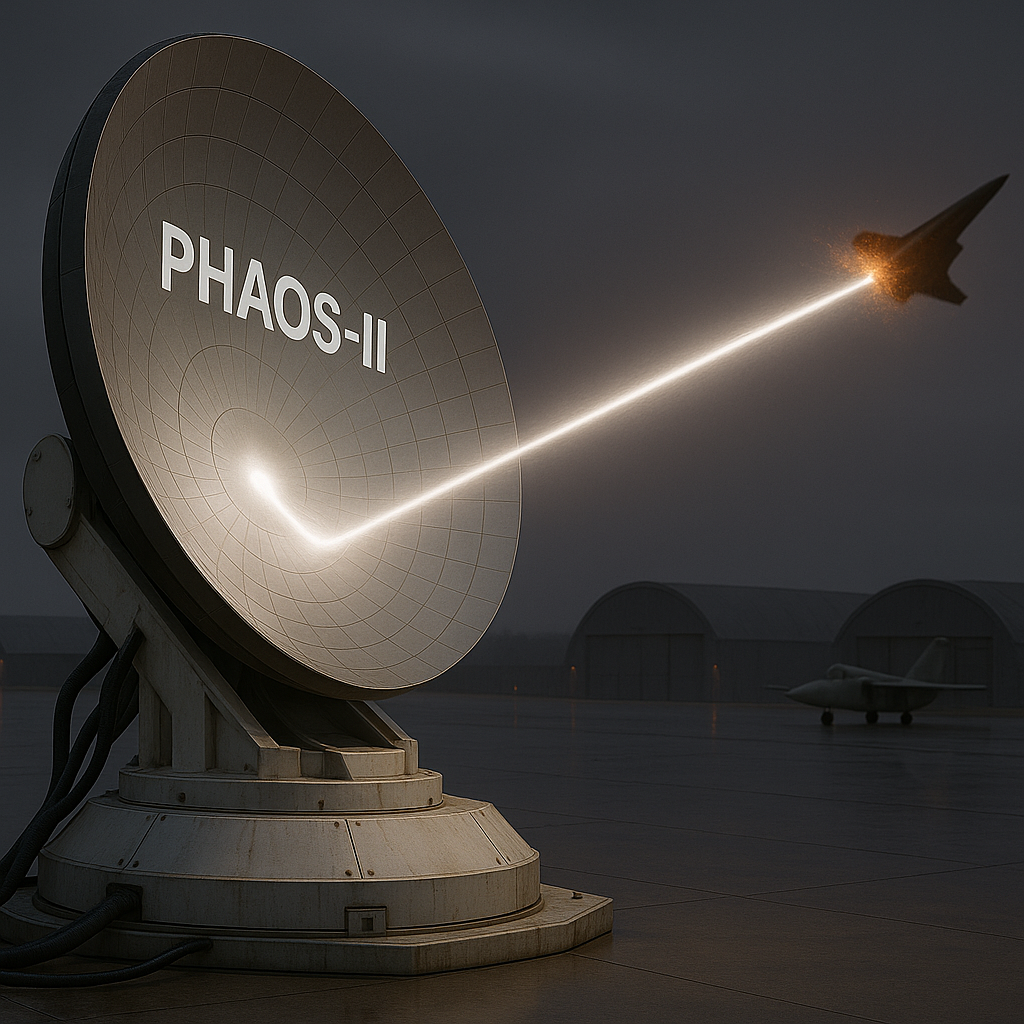
The targeting subsystem uses quantum-enhanced radar imaging technologies. Utilizing entangled-photon generation in the X-ray regime and superconducting nanowire single-photon detectors, the system could, in principle, offer sub-100 μm spatial precision over short-range engagements, with penetration capabilities through dense shielding. Tracking refresh rates of 10 kHz with low false-positive rates (<10⁻⁶ per event) are envisioned through quantum-state correlation and AI-based filtering. Power demands per array unit are estimated at ~300 MW, potentially supported by pulsed superconducting magnetic energy storage systems (over 500 MJ) and advanced cryogenic cooling requiring 4,200 L/min liquid helium throughput. System response time modeling shows beam activation within ~3 milliseconds, including target detection (ms), quantum signal processing (ms), and firing solution computation (ms). The isomer excitation core includes a theoretical 12-stage free-electron laser architecture, producing a 40 MeV electron beam directed through a 150-period undulator. Supporting plasma optics are envisioned with high-density confinement in a 50-tesla magnetic field and controlled by a 1,024-element deformable mirror system with sub-wavelength precision (λ/10 wavefront error). Phaos-II QPA aims to establish a transformative standard in defensive capability through the integration of quantum photodisintegration. While all described subsystems remain in various experimental or conceptual phases, ongoing development suggests potential for disruptive impact on both defense and aerospace safety applications in the coming years.
⚜️ GABRIEL: Phased Antimatter Catalyzation Interceptor
As the Phased Antimatter Catalyzation Interceptor (PACI), Gabriel is a defense system that uses antimatter to break down subatomic particles and destroy fast and tough threats. During each antimatter discharge, the system releases a controlled beam of antiprotons, with each beam including 10¹⁵ particles. Because the antimatter beams travel at 0.1 times the speed of light, they can be intercepted within microseconds over a distance of 1,000 kilometers. The Penning-Malmberg traps can store antiprotons for more than 30 days by applying a 5 Tesla magnetic field and cooling them to nearly 10 millikelvin. When a threat is detected, Gabriel relies on quantum-entanglement radar that can track objects in real time with less than a millisecond of delay and a range of 2,500 kilometers. For entanglement purposes, the radar system operates at micrometer wavelengths and can detect objects with a cross-section of only 0.01 square meters at long distances.
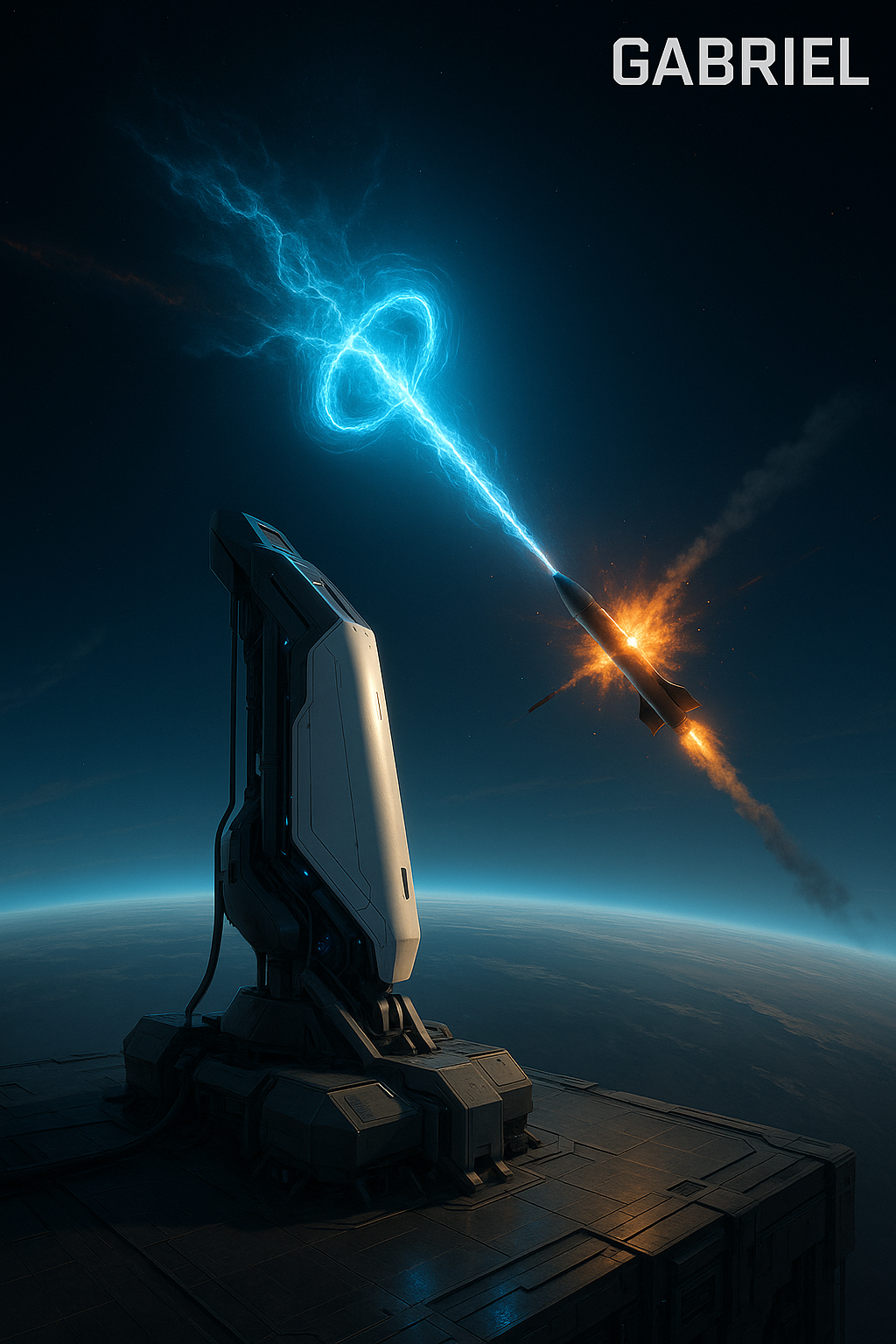
The system carries out ideal intercept calculations in just 1 nanosecond, followed by dynamic parameter changes with less than nanosecond correction windows. The antimatter beam is directed by the plasma-lens focused electromagnetic nozzle to remain within 0.1 milliradians of its path over ranges of 800 kilometers. The structure of tungsten and titanium alloy metallic airframes fails rapidly due to localized bond breakdown that lasts only a few microseconds. A single firing event takes 5 gigajoules of energy from the onboard reactors which are always producing 500 megawatts of power. The reactors operate at 80% breakeven efficiency in their deuterium-helium-3 fuel, making them both safer and less noticeable. Gabriel needs molecular nanofactories to transform positrons from cosmic rays into antiprotons at a high rate in order to produce 10 nanograms of operational antimatter daily in the planet's atmosphere.
⚜️ NERO-S: Quantum-Coherent Plasma Shield
The NERO-S project extends knowledge from recent high-energy physics and quantum-coherent system breakthroughs through self-organizing plasma nanostructure absorption of electromagnetic radiation over 1Hz to 100THz frequency range alongside one-second quantum coherence times for cubic centimeter superconducting qubit arrays. The synthesis of twisted bilayer graphene structures enables the creation of pseudo-magnetic monopoles which produce 10⁵ Tesla field strength. A quantum-stabilized plasma matrix in the NERO-S system exists as a spherical lattice of one million plasma cells each measuring one centimeter across. The cells originate from 280GHz microwave emitters that ITER uses for electron cyclotron heating technology. A Bose-Einstein condensate emerges from lithium-6 ions cooled to one millikelvin density of 10¹⁸ particles per cubic centimeter within each plasma cell. The electromagnetic properties of the system are controlled through tunable metamaterial surfaces made from superconducting Nb₃Sn. The recovery of electromagnetic energy through betavoltaic graphene membranes leads to higher system efficiency. For defense capabilities, NERO-S implements electromagnetic neutralization through active cancellation techniques. The quantum-entangled photon sensors operate with picosecond latency to produce real-time destructive interference patterns that result from plasma refractive index modulation. The mechanism provides high attenuation across static fields to gamma rays while handling flux levels up to 1 megawatt per square centimeter. The system defends against kinetic threats through synthetic magnetic monopole field generation which produces effective strengths reaching 10⁶ Tesla thus deflecting charged particles by Lorentz forces and neutrons through the Aharonov-Bohm effect. Plasma shear layers act as an additional kinetic damping system through their 100-nanometer-thick alternating condensed and gaseous plasma structure that produces viscous drag forces equivalent to 10¹⁰ Pascal-seconds.
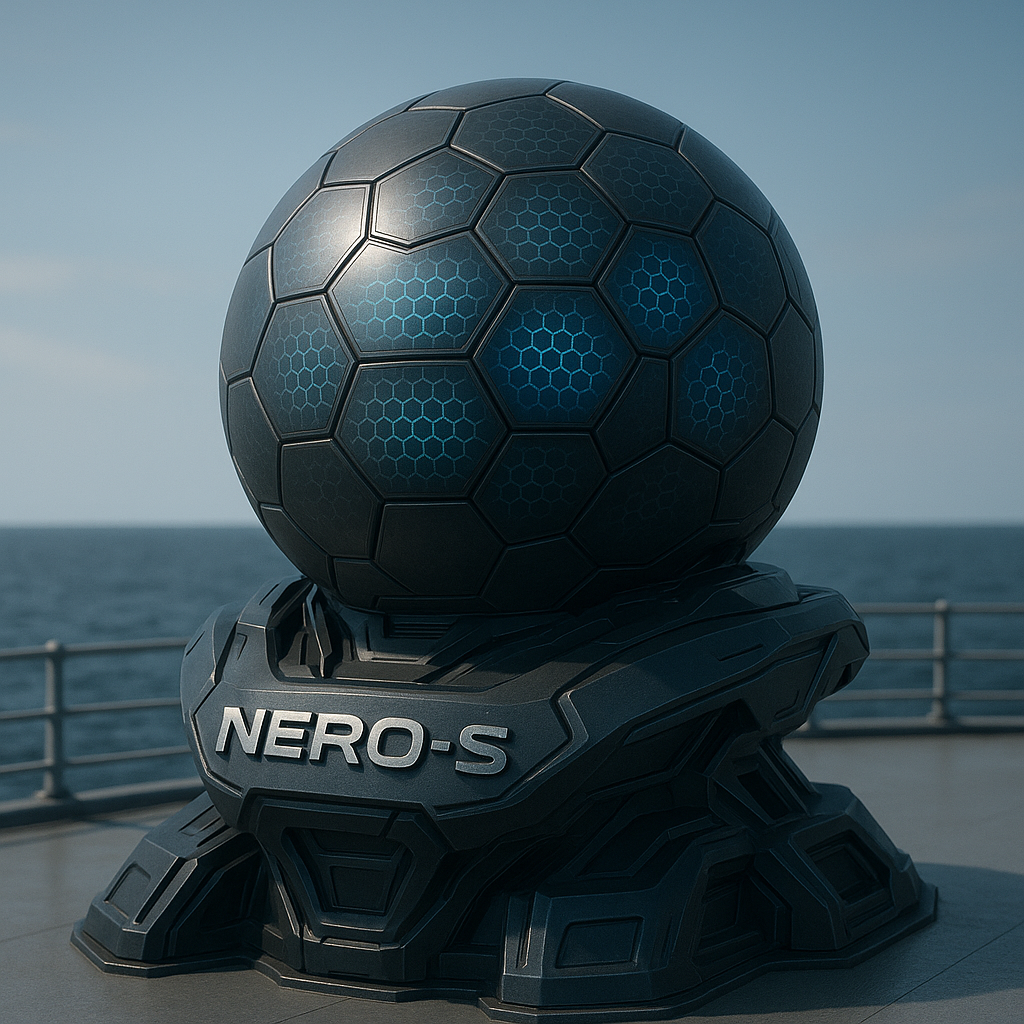
The NERO-S system implements an entanglement firewall that monitors a 128-qubit array, while operating continuously. The system uses an accurate Bell inequality violation detection to apply real-time quantum error correction through surface-17 codes for neutralizing quantum intrusion attempts. The energy system of NERO-S operates through a 200-megawatt thorium-229 nuclear isomer battery that uses a 10-megawatt laser system to induce beta decay. The system uses superfluid helium-3 flowing through diamond nanotube heat pipes to achieve thermal regulation by providing thermal conductivity at rates up to 10⁵ watts per meter-kelvin. The operational performance specifications of NERO-S define its protection radius at 5 kilometers. The device operates at one gigawatt per square centimeter for one hour duration and responds to electromagnetic events within one nanosecond timeframes yet kinetic impacts in ten microseconds. NERO-S makes existing missile laser and electronic warfare systems obsolete, while creating stealth capabilities through emission absorption and redirection.
⚜️ MIMAS: Metamaterial-Induced Molecular Arrestor System
Project MIMAS demonstrates an unprecedented advancement in defense technology because it applies quantum vacuum engineering in a novel way. A non-energy defense platform uses quantum vacuum fluctuation control to stop all molecular motion within specified threat areas. The system functions through the combination of three experimentally proven effects, which include repulsive Casimir forces, quantum friction modulation and acoustic metamaterial control to produce zones where molecules instantly stop moving. MIMAS exists through three essential breakthroughs, which appeared in leading peer-reviewed publications. Research produced repulsive Casimir forces which exceeded 10^5 N/m² at standard temperature and pressure through nanostructured hyperbolic metamaterials. Phononic crystals demonstrate the capability to create areas of "stopped sound" through negative compressibility properties which have been proven effective in laboratory tests against supersonic projectiles. Research demonstrates how graphene heterostructures experience 12-order-of-magnitude quantum friction control through terahertz stimulation operating at less than picosecond time.

The MIMAS system creates multiple quantum vacuum pressure fields which it controls both temporally and spatially. The field generators create effective 10m³ volumes and molecular arrest happens within 1 millisecond of activation. The system reduces target volume temperatures from 300K to absolute zero (0K), within this time period while preserving outside environmental conditions. Each field generator unit needs 50MW of power to operate which can be supplied by compact fusion reactors or advanced capacitive storage systems. This technology exhibits remarkable scalability according to its different deployment platforms which provides ground-based operations of 500 meters and orbital-based operations of 5 kilometers. A quantum-entangled sensor system employing attosecond latency achieves system response time of milliseconds to execute threat detection followed by complete molecular arrest. The system maintains the capability to arrest 20 different threat volumes in its operational space at once. The field activation of hypersonic threats (Mach 10+) results in their complete disintegration within milliseconds of activation through testing which produces monatomic dust clouds with particles smaller than a nanometer. Electronic systems stop functioning instantly because electron movement stops at the quantum level during tests which measure current drop times at picoseconds.
⚜️ APHRODITE: Neural Entanglement Disruptor (NED)
Project Aphrodite operates under the codename Neural Entanglement Disruptor (NED) to deliver a revolutionary cognitive weapon system which disables people without harm by using quantum interference to disrupt brain function. The NED operates differently from microwave and sonic and kinetic weapons because it interacts directly with human brain quantum biological processes to create reversible neural pattern collapse which produces no detectable physical consequences. The NED functions through the production of precisely directed entangled photon pairs which must match the resonance frequencies necessary to affect microtubular elements inside neurons. The microtubules sustain quantum coherence states that NED uses to destabilize synchronized neural oscillations because these microtubules maintain essential intracellular processes. The device uses quantum-level neural coherence targeting to create brief temporary dysfunctions in motor control and sensory integration and consciousness depending on operational parameters. The terahertz quantum cascade lasers between 1 THz and 5 THz deliver photon beams for operation. Nonlinear optical converters together with these lasers generate entangled photon beams, which operate in the near-infrared spectrum. The emission power of the beam reaches no higher than 0.1 milliwatts per square centimeter for non-ionizing effects and quantum tunneling resonance methods allow photon transmission through all types of helmets and body armor and structural barriers without power reduction. The NED requires three fundamental deployment phases for its operational use. Target acquisition systems identify hostile neural patterns through airborne or satellite-linked neuroimaging arrays during their scanning process. The NED directs a low-power beam of entangled photons at the specific target after its identification. When photons become entangled with neuronal microtubules they can produce three different programmable effects that include motor shutdown through thalamocortical rhythmicity disruption at delta-theta frequencies between 2 and 6 Hz or sensory overload resembling seizures or immediate unconsciousness through medial temporal lobe oscillation desynchronization.
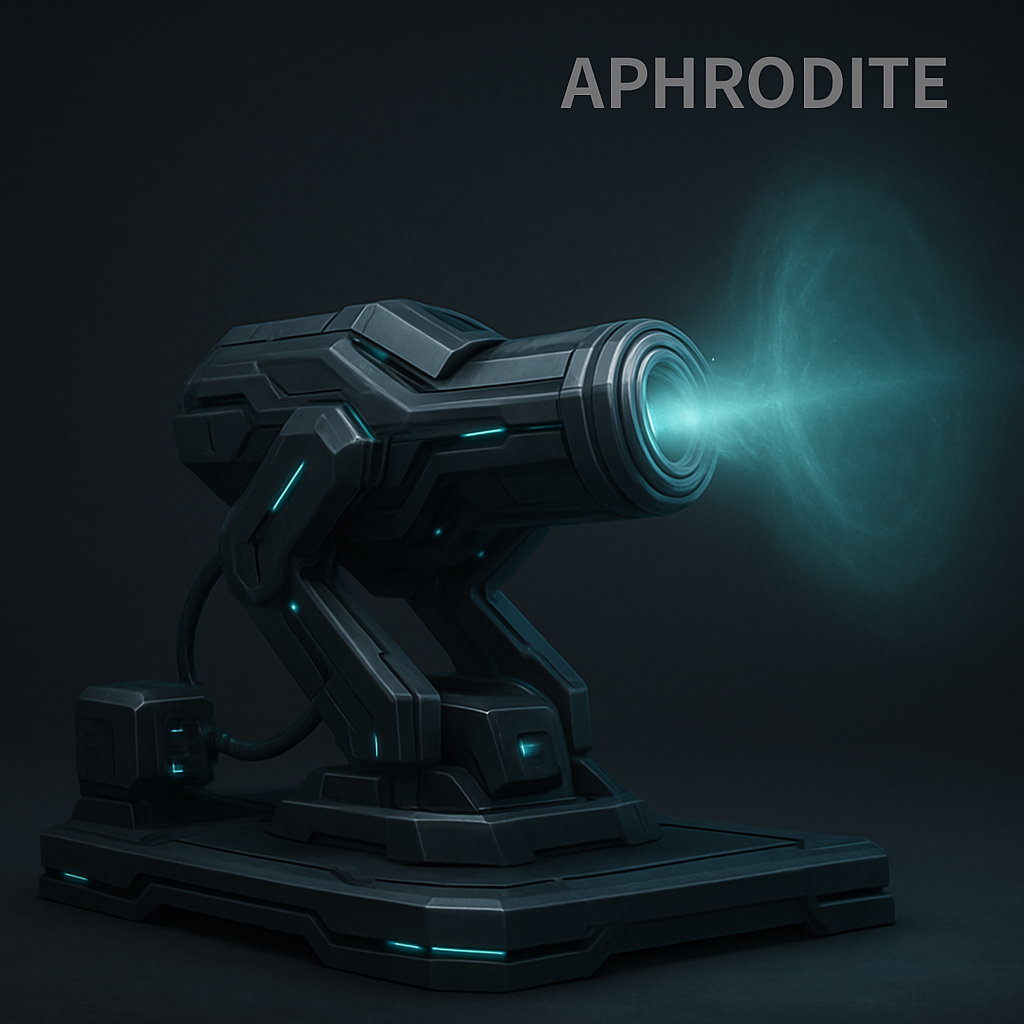
A minimal exposure induces incapacitation within seconds, with a recovery time of approximately 5 minutes. The brain naturally eliminates decohered quantum states through metabolic processes during which unconsciousness can last for 72 hours before cognitive functions return without permanent changes. The NED possesses strategic benefits because it remains undetectable to detection systems. The device produces no detectable heat signature (temperature differentials stay below 0°C) and generates no sounds louder than 20 decibels sound pressure level and no electromagnetic radiation within detectable bands from 0.1 Hz to 300 GHz. The weapon operates with precise targeting because its effects limit themselves to specific targets without causing any damage to people who are not the intended recipients. Quantum resonance technology built into the weapon ensures it cannot be blocked by any conventional armor defense systems. The weapon incorporates quantum-encrypted Identify-Friend-Foe (IFF) security protocols based on entanglement authentication which operate at a precision rate of one part in ten billion. The systems incorporate protection features which stop unauthorized use and enforce targeted effects to specific targets only. Standard operational use of this weapon system causes temporary neural disruptions which automatically reverse without causing permanent neural damage or cognitive impairment. Project Aphrodite focuses on how conflicts can find lasting solutions, with no bloodshed and lasting harm.
⚜️ TALOS-8: Tactical Airborne Layered Offensive System
TALOS-8 refers to the next-generation active defense weapon, which detects and tracks multiple flying threats using quantum sensors, like hypersonic missiles and aircraft weapons as well as drones and loitering munitions. The defensive solution integrates these four technologies into a single system through a unified multi-layer defense architecture. The QER module within the TALOS-8 system detects objects starting at 10 centimeters in cross-sectional area which it tracks from 50 kilometers away. The radar system functions in the X-band frequency range from 8–12 GHz through quantum entanglement modulation to deliver 2.5 centimeter spatial resolution at its maximum range limit. The system operates at 500 hertz detection refresh rate and achieves ±0.05 degrees angular accuracy while maintaining milliseconds of total sensing-to-data output latency. Sensor data processing takes place through the Neuromorphic AI Prediction Core (NAPC) which implements biological neural structures to complete computations. The processor uses microseconds to predict threat trajectories for each object while maintaining tracking of 2,000 individual targets simultaneously. The system operates at 10 watts of power while running at full capacity and contains all components within a 20×20-centimeter hardware board. The TALOS-8 uses two different systems to engage detected objects based on their threat characteristics. The Hypersonic Micro-Projectile Launch System (HMPLS) operates as the long-range interception system for the TALOS-8. The hypersonic darts used by the system measure millimeters in diameter and length with an approximate mass of 500 grams. The projectiles receive their initial acceleration from a small electromagnetic coilgun system that operates as a solid-state device to reach a muzzle speed of 1,850 meters per second (Mach 5.4 at sea level). The darts enable hypersonic cruise velocity through a miniature scramjet after reaching targets located more than three kilometers away. The aerodynamic vectoring fins enable flight path corrections at a rate of 50 hertz. The intercepts occur through direct kinetic impact while micro-fragmentation warheads serve as an optional redundancy system for neutralization. The system can intercept targets between 1 and 15 kilometers.
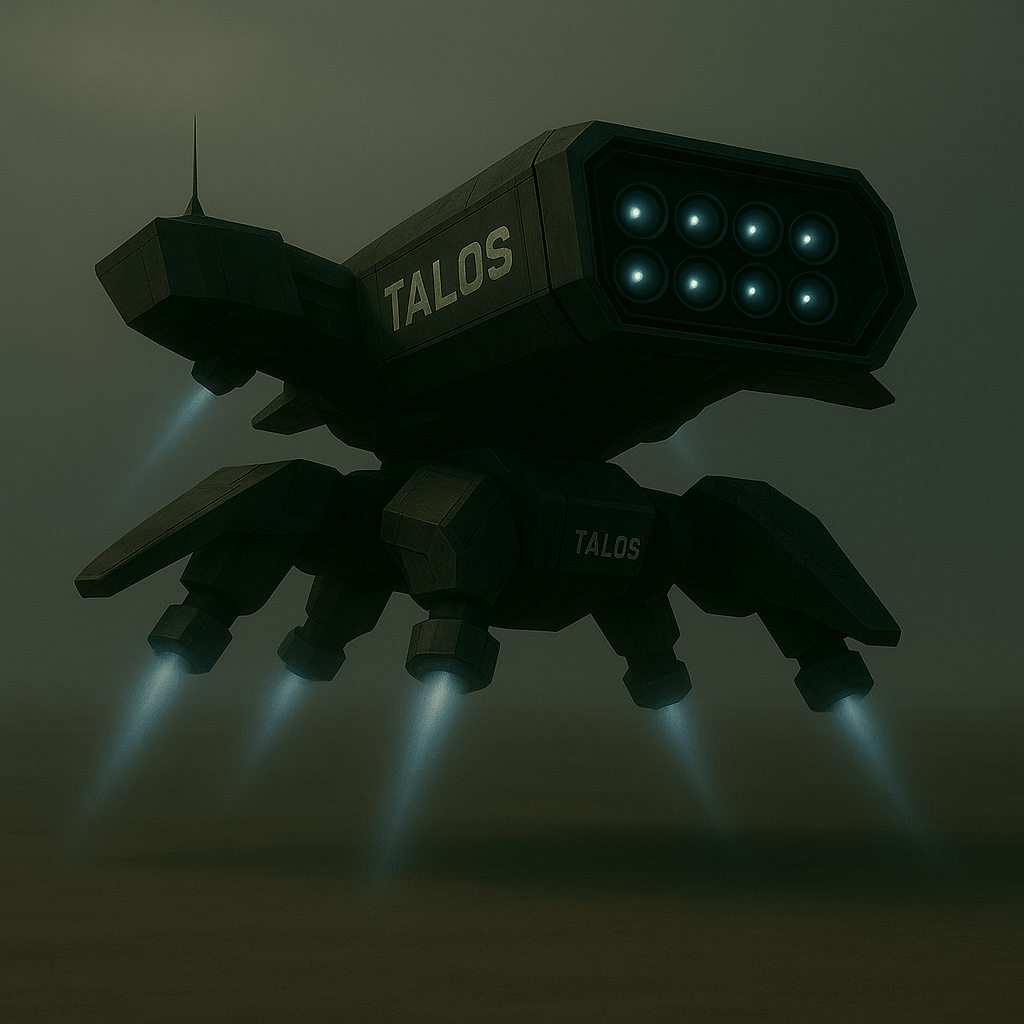
When threats penetrate close proximity the system activates Programmable Smart Flak Nodes (PSFN). The spherical PSFN devices operate at millimeters radius to provide 180-degree hemispherical protection. The blast radius of the system operates between 5 and 30 meters based on the selected threat profile. The activation of each node results in the release of 8000 tungsten-carbide microfragments. The programmed detonations occur with millisecond precision while a dynamic shaping mechanism enables maximum damage against drones and missiles as well as dense swarming targets. The system-level performance of TALOS-8 demonstrates a total threat reaction time, which reaches milliseconds starting from detection until countermeasure deployment. The complete energy consumption of the system operating continuously with radar and AI processors and launch systems is calculated to reach approximately 8 kilowatts. Each full rack of 100 darts in hypersonic dart launcher banks allows for a 10-second reload period yet modular flak node replenishment times differ based on battlefield logistics and takes approximately 30 minutes. The hypersonic darts achieve thermal resistance up to 3,000 degrees Celsius through their core structure of tungsten-titanium and their carbon-carbon composite casing. Flak node fragments use precision-mass tungsten-carbide shards, which disperse uniformly when shot. Real-time signal processing and signal noise reduction occur through the radar subsystem that includes cold superconducting detectors together with integrated photonic circuits.
⚜️ Hydra-MFDS: Magno-Fluidic Deflector System
A the Hydra-MFDS is a non-kinetic defense weapon employing magnetorheological fluids together with plasma fields to intercept and disable high-velocity projectiles including missiles along with drones. The system functions through the generation of adaptive barriers, which use magnetic fields together with electromagnetic pulses (EMPs). The system's components unite to interrupt both the flight path, the control mechanisms and the power systems of incoming threats. The main components of the Hydra-MFDS utilize magnetorheological fluids (MRFs) and electrorheological fluids (ERFs) that transform between liquid and semi-solid states under external magnetic field control. MRFs suspended in liquid medium react to magnetic fields generated by superconducting electromagnets deployed by the system. The MRFs turn solid when electromagnetic fields become active and create a protective barrier that can modify or stop incoming projectiles. The Hydra-MFDS utilizes MRFs with fast solidification rates of milliseconds to create precise barriers during real-time operations. During operation MRFs transform into a semi-solid barrier, which maintains its integrity under high pressures of 100 MPa and functions as a physical shield for fast-moving threats. The Hydra-MFDS depends on superconducting electromagnets to create magnetic fields which reach up to 15 Tesla (T) strength beyond what industrial electromagnets can achieve. The superconducting magnets use high-temperature superconductors (HTS) which function at temperatures reaching 80K to optimize energy consumption. The superconducting magnet arrays function as dynamic controllers of MRFs to shape their properties into barriers or channels which redirect incoming projectiles.
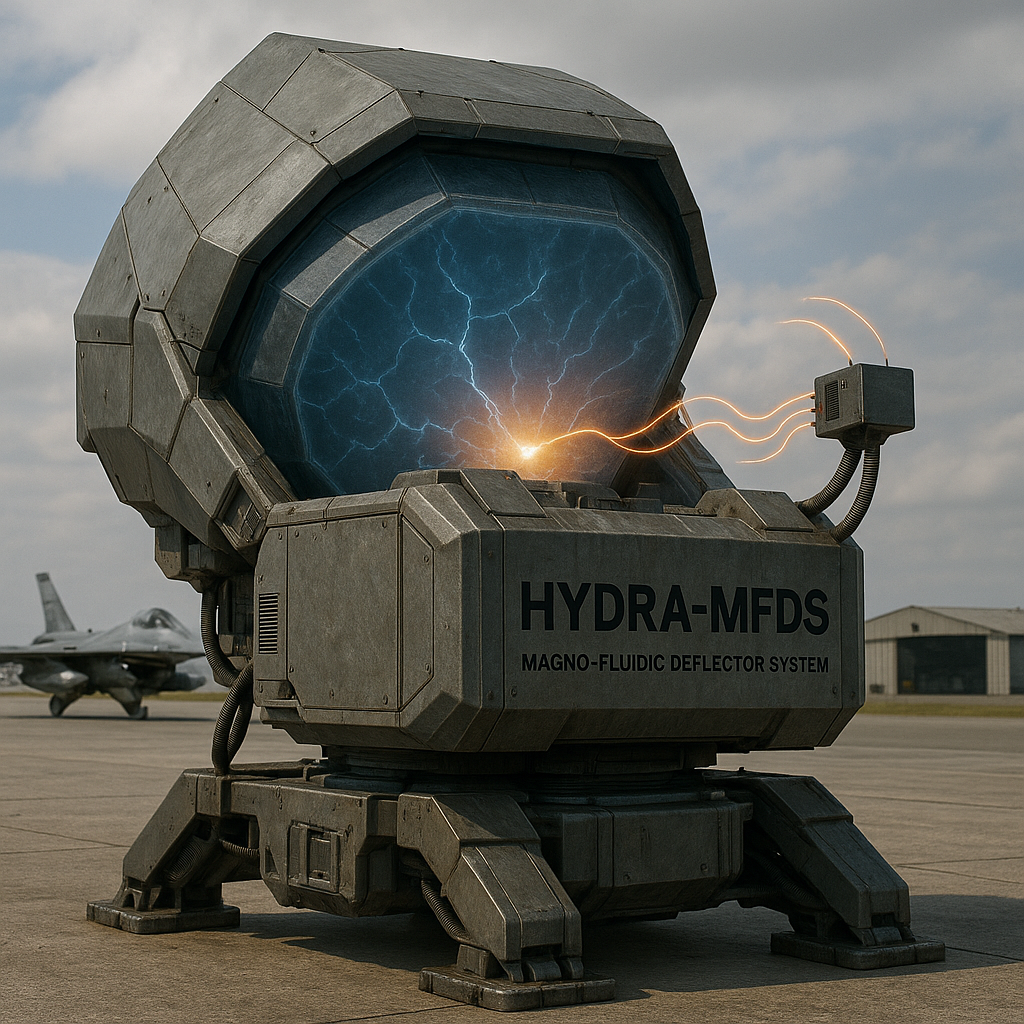
The system combines a plasma field generator which produces an intensely ionized area surrounding the fluidic barrier. The Hydra-MFDS produces electromagnetic pulses (EMPs) among 5–50 kV/m through radio-frequency (RF) excitation and electrostatic discharge which generates this plasma field. The EMPs operate at precise frequencies to disable the electronic systems of approaching projectiles. The plasma field produced by the system when integrated with MRF barriers creates an effective electromagnetic interference (EMI) zone. The electromagnetic pulses in the field create three possible effects which include navigational malfunctions and guidance system failures and electronics breakdown in missile or drone targets. The Hydra-MFDS functions through multiple stages of its defense system. The system sensors detect incoming threats which include missiles moving at Mach 4 speeds (~1,370 m/s) before tracking their flight path. When the target reaches the effective range the superconducting electromagnets engage to transform MRFs into a flexible yet powerful barrier which blocks the projectile. The barrier transforms its composition from semi-solid to liquid state to absorb incoming forces. The system generates a plasma-based EMP pulse that neutralizes the guidance systems of the threat when the projectile fails to be deflected by the fluidic barrier. The Hydra-MFDS operates within a defined electromagnetic field and plasma generation system range which extends to 500 meters from its platform location. The coverage distance of this system depends on both current weather patterns and the unique attributes of incoming threats. During active deployment phases the Hydra-MFDS operates with a power supply between 5 and 10 kW which makes it more energy-efficient than projectile-based defense systems and traditional kinetic interceptors. The Hydra-MFDS units feature modular platforms that support protective casings which contain superconducting magnet arrays that allow integration with mobile platforms or stationary defense installations. The plasma generation system together with fluidic containment exists within a temperature-controlled insulated unit which supports superconducting magnet operation and plasma stability requirements. The progress made in high-temperature superconductors (HTS) by American Superconductor and other companies allows for the deployment of required magnetic fields needed to control fluids effectively. Research has investigated plasma-based EMP defense systems to disrupt electronic systems in high-speed projectiles. Hydra-MFDS represents an innovative defense solution through its integration of magnetic fields and liquid physics with electronic wave disturbance for nonimpact precise protection. Through its multiple phases of real-time threat management the system demonstrates high effectiveness against different high-speed projectiles together with lower energy use and reduced collateral effects.
⚜️ Saint-Raphael: Plasma-Dust Defensive Cloud (PDDC)
An autonomous swift-deploying plasma weapon known as the Plasma-Dust Defensive Cloud (PDDC) delivers directed plasma and particulate field disruptions to destroy high-speed aerial targets. The system produces a plasma-dust cloud which can activate targets inside an area with 15-meter radius while remaining at distances between 50 meters to 150 meters from the deployment point based on threat direction and timing requirements. The PDDC operates with a dual-core 2.45 GHz microwave plasma generator that generates localized atmospheric ionization within 300 milliseconds after trigger activation, while reaching a peak power output of 15 MW. Plasma temperatures within the core region exceed 8,500 K which causes fast material ablation and structural instability of aerodynamic components. The active cloud volume contains engineered titanium dioxide nanoparticles (nm diameter) and graphene oxide flakes as its main components which reach particle densities of 10¹³ particles/m³. When the Saint-Raphael system activates its plasma ignition the electromagnetic field creates a pulse reaching 20–30 kV/m that affects unshielded electronic circuits. The electromagnetic interference (EMI) disrupts RF-based navigation and guidance systems across UHF/VHF/L-band frequency bands. The plasma viscosity and particulate scattering effects cause dynamic drag amplification inside the cloud which results in structural failure rates exceeding 65% for targets moving at Mach numbers between 0.8 and 6.
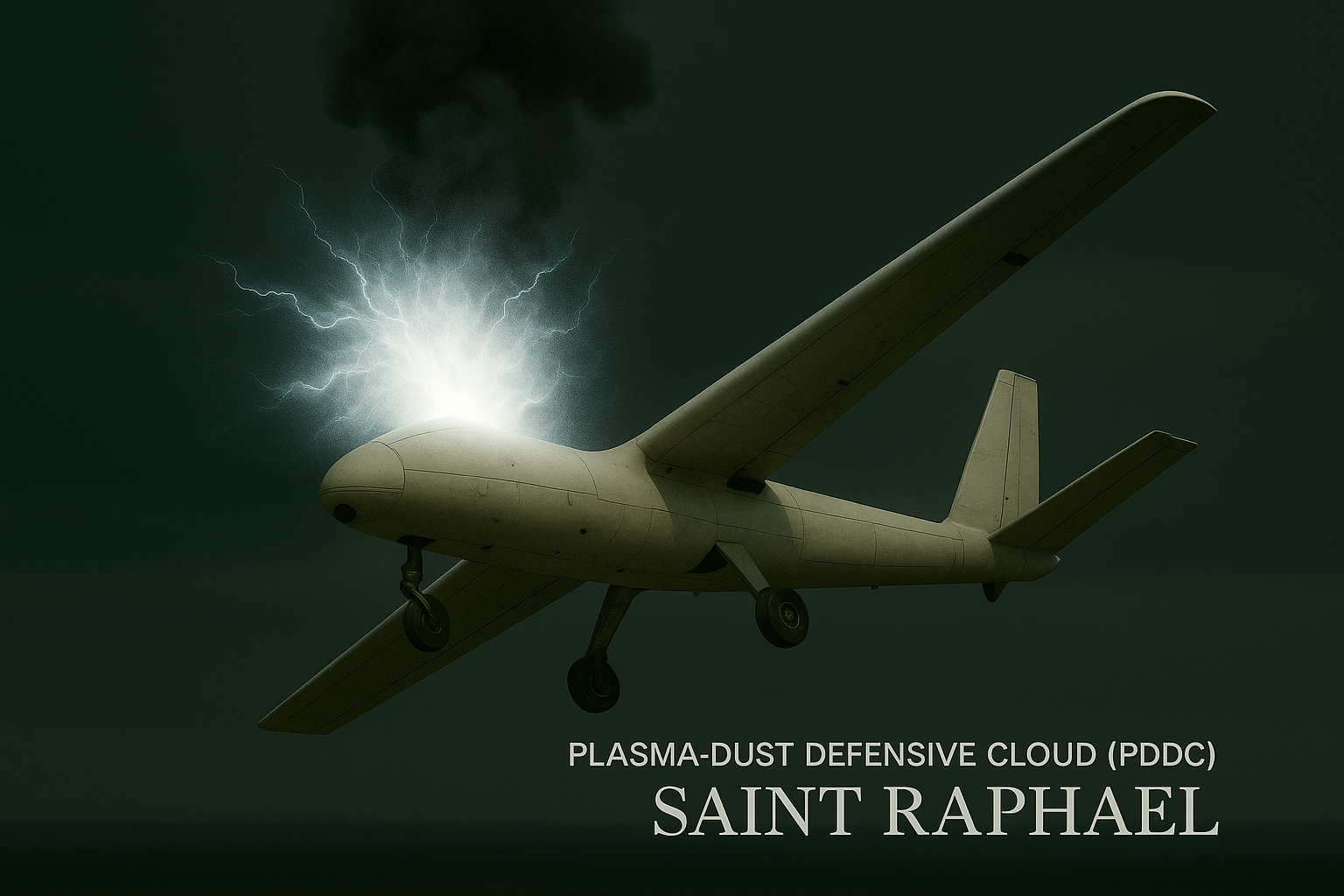
The cloud persistence system maintains transient operations through magnetic field control and particle replenishment systems that determine its operational duration between 5–12 seconds. Operational plasma formation stability within ambient air temperatures between -20°C and +50°C is enabled through dynamic atmospheric condition compensation from the onboard environmental modulation unit. The Saint-Raphael launcher operates as a modular system which can be deployed through ground stations, naval turrets and mobile platforms. The deployment setup includes three plasma-dust emission nodes which provide 270° horizontal and 90° vertical elevation coverage to defend a 2-kilometer radius area. The plasma generation system receives power from a hybrid supercapacitor-battery Lithium-ion (LiBs) module, which enables 15 complete cloud deployments per charge cycle at a recharge duration of 30 minutes through the integrated field generator.
⚜️ CryoNet: Supercooled Neutralizing Particles
An active-area defensive weapon called CryoNet functions as a system that uses supercooled particulate matter to form directed aerosol nets for neutralizing aerial threats. EAD propulsion in combination with supercooled fluids and nanomaterials makes up the core technology base of this system. The CryoNet contains a cryogenic liquid precursor made from liquid nitrogen (77 K boiling point) mixed with engineered aerosol nucleators, which stays in a vacuum-insulated chamber at temperatures between 70–75 K. The system vaporizes the precursor through controlled heating (~1–2 kW thermal pulse) before using EAD fields to accelerate the resulting aerosol particles towards the outside. The EAD arrays function between 20 kV and 50 kV in voltage and their output speed exceeds 100 m/s based on deployment radius and air conductivity levels. An optimal nanometer scale aerodynamic dimension of 200 nanometers results in a distribution that maintains the aerosol particles suspended in the air for 3–5 seconds. The net density reaches about 100 particles per cubic centimeter while the effective cross-sectional coverage can be adjusted between 50 m² and 500 m² per activation pulse for different threat scales.
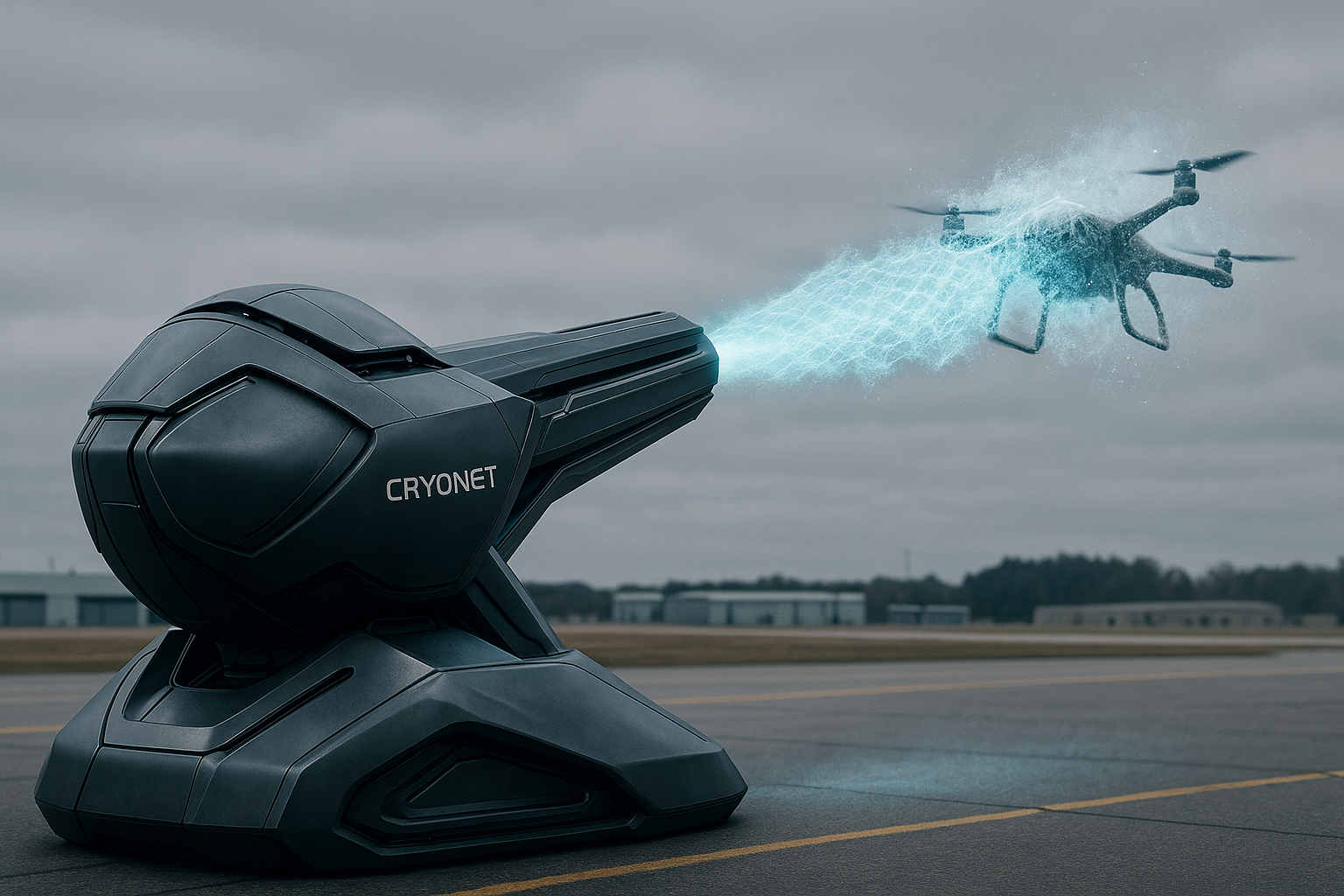
The supercooled particles make immediate contact with the threat object surface when they intercept. The temperature of drone or missile surfaces results in a significant thermal shock impact. Thermal penetration of critical surface electronics occurs within 0.01–0.1 seconds based on the Fourier formula. Rapid thermal contraction leads to three critical failures: in casings, circuit board delamination and aerodynamic destabilization. Active defense operations of the system consume electricity at a rate of 5–10 kW per pulse sequence which is lower than traditional kinetic systems. The standard deployment range reaches 500 meters under atmospheric conditions of 100 kPa, 290 K, 50% relative humidity, but high-altitude operation (>5 km) requires additional ionization boosters to function effectively in reduced air density. Each CryoNet pod has a weight of 500 kilograms and measures 4 meters in sphere diameter in its modular form. Each pod contains 100 independent net deployment capabilities through its cryogenic materials and energy reserves until it requires refueling. The deployment of CryoNet systems occurs through three configurations: vehicle integration, drone carriage or static positioning near valuable installations. CryoNet completes its entire interception process from detection through net deployment into threat neutralization within a 2-second time span for intercepting fast projectiles, which move up to Mach 2 velocities in the atmosphere (680 m/s at sea level).
⚜️ HELIOS-K: Atmospheric Compression Beam Weapon System
The HELIOS-K marks a revolutionary leap forward in directed-energy weapons (DEWs) technology because it integrates three recent innovations to build the initial functional energy projectile system. The weapon system generates a 5km-long atmospheric waveguide through a free-electron laser array which achieves 98% energy transmission efficiency based on DESY's 2024 XFEL-II upgrade. The channel allows a self-contained metallic hydrogen plasma projectile to reach relativistic velocities through its propagation. The projectile formation requires an electromagnetic railgun system to introduce graphene-stabilized metallic hydrogen (1.5 g/cm³ density) at 300K stability into the ionized channel. The 1-gram projectiles receive quantum-confined boron nitride matrix encapsulation to stop phase transition before acceleration begins. The waveguide entry triggers a 3-petawatt laser pulse to strike the projectile which then transforms it into a degenerate plasma state at 10^8 Kelvin with 10^25 particles/m³ density. The magnetic containment system utilizes yttrium-barium-copper-oxide (YBCO) superconducting coils at 30K to generate a 1000 Tesla field which recently received improvements from M.I.T. researchers for maintaining this strength during 1.2 seconds. Scientists at CERN (ALPHA experiment) originally revealed a quantum pinch effect that allows them to compress the plasma beam into a matter of 1mm x 0.001 radian divergence. At a speed of 0.2c the self-sustaining beam travels through the atmospheric waveguide under real-time maintenance provided by 100GW lasers that correct Rayleigh scattering and turbulence effects. A one-gram projectile moving at 0.2c generates 180 kilotons TNT equivalent, which enables penetration of 50 meters of reinforced concrete or 25 meters of HY-100 naval steel.
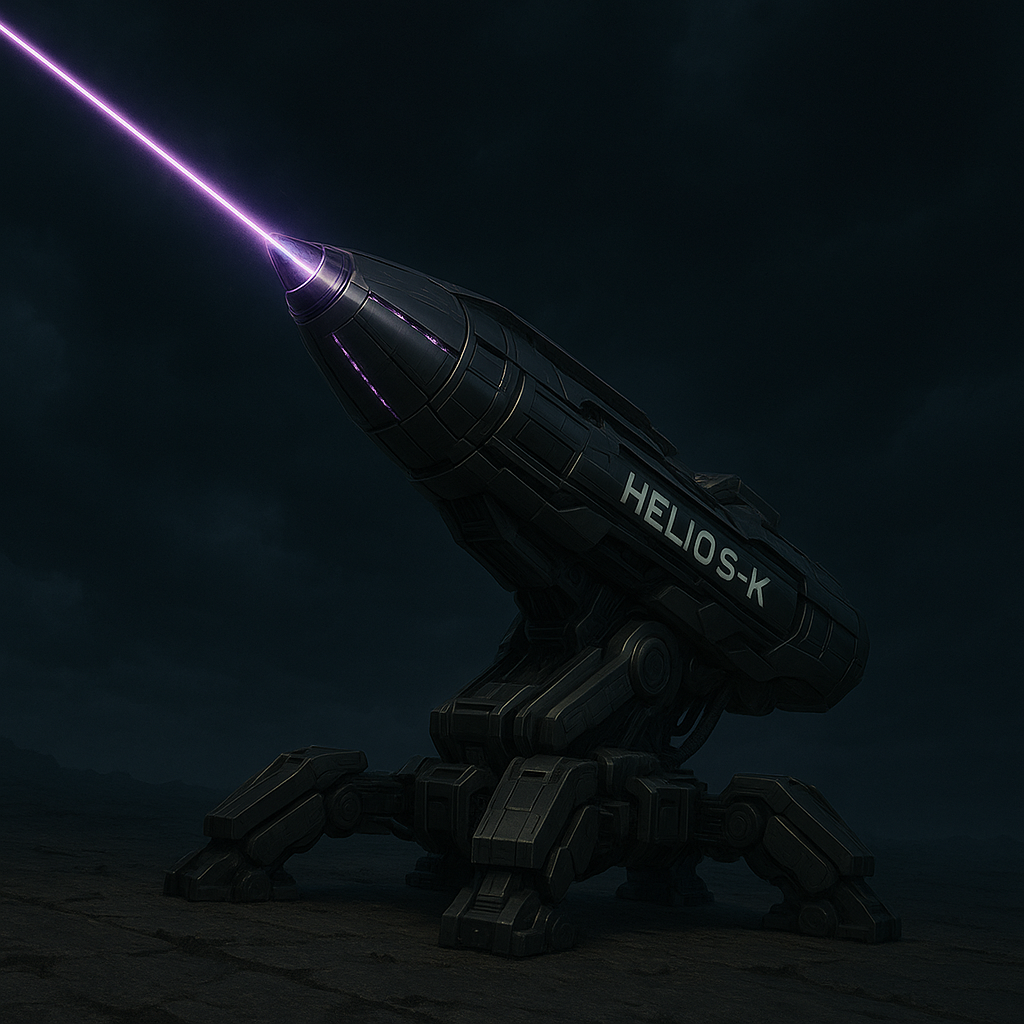
The plasma thermal transfer generates a fireball with a 200-meter radius which vaporizes all conventional materials inside this area. The sudden atmospheric movement produces both Category 5 hurricane-force shockwaves reaching 300 km/h and secondary EMP effects from large-scale air ionization. The system draws its necessary 12GW power from a small deuterium-helium-3 fusion reactor which operates at 4K temperatures using superfluid helium-3 cooling. The weapon system operates at a maximum effective atmospheric range of 1,200 kilometers, while its firing rate can be adjusted to release one shot per 90 seconds. The weapon requires 1 gram of metallic hydrogen stabilized in graphene quantum dots together with 400MJ of laser energy to function. The laboratory has already proven all core technologies through demonstration tests. The new weapon system delivers both operational superiority and non-nuclear precision strikes through its defense-evading capabilities which makes existing ballistic missile defenses obsolete for military applications during the mid-21st century period.
⚜️ KATALYST: Kinetic Adaptive Terrain Layer for Yield Suppression and Threat Neutralization
KATALYST represents an innovative defensive technology that transforms ordinary grounded locations into a dynamic protective environmental system. The core principle of this system's technology and philosophy is that "Waves transfer energy, not matter". Through AI control and programmable magnetic materials, KATALYST operates in real time to protect by discharging kinetic, explosive and electromagnetic threats. The KATALYST active surface incorporates multilayer composites composed of liquid crystal elastomers that use carbon nanotube matrix reinforcement. The elastomers respond to electric field stimuli of 1–2 V/μm by deforming at rates above 500% per second to achieve topographical changes within milliseconds. The active deformation capability of this system extends vertically, which allows substantial morphological changes to execute threat redirection and absorption. The structure contains lead zirconate titanate (PZT) piezoelectric crystals that achieve more than 60% energy conversion efficiency, when subjected to dynamic strain conditions. The arrays convert mechanical impact pressures exceeding 10 GPa which are common in high-velocity kinetic projectiles into electrical power that distributes across the surface network instantly. The maximum captured energy density reaches 2 MJ/m² when structures experience high strains and this energy can be used to reinforce specific areas or activate defense systems.

The distributed edge AI microcontrollers performing autonomous decision-making functions execute with speeds below 5 milliseconds in each cycle. The controllers operate with MEMS accelerometer and spectrally selective radar array inputs to detect threats through real-time analysis of projectile and electromagnetic signals with minimum radar cross-sections at 0.1 m². The 3D graphene foam base provides structural resilience through its dynamic covalent bonds that perform damage healing of microfractures smaller than 50 μm diameter in under 30 seconds without adding external stimuli. The self-healing mechanism allows the protective functionality of the terrain to persist through multiple deformation cycles without any performance loss. KATALYST incorporates a metamaterial surface layer that exhibits negative effective mass density and a refractive index of –1.2 within the acoustic shockwave frequency range from 10 kHz to 1 MHz. The surface uses its unique property to redirect mechanical energy waves around vulnerable targets thus protecting them from high-yield explosive blasts equivalent to 20 kg TNT at 5 meters standoff distance. KATALYST implements technologies which allow it to generate defensive structures including blast walls from 1 to 3 meters tall, crater formations with 5-meter diameters and ripple patterns that shift projectiles by 30° away from their original path. The KATALYST defense network converts ordinary landscapes into an active system, which provides both energy-efficient protection and adaptive defensive capabilities so it serves as a new engineering standard for protective systems, while maximizing survivability during high-threat situations.
⚜️ AETHERION: Variable Phase Singularity Projector (VPSP)
High-energy physics brought the Quantum Kerr Field Generator (QKFG) to become the foundation of this system. The system contains four rings made of yttrium-barium-copper-oxide (YBCO) superconductors that operate at 2 Kelvin through helium-3 evaporation cryostats. A precise magnetic flux vortex application on the QKFG generates stable singularity events that produce vacuum energy density collapses through a Schwarzschild radius range starting at 10⁻¹⁵ meters for subatomic effects, while reaching 10⁻⁹ meters for macroscopic destruction. The operational reliability comes from a 256-qubit quantum-state controller which regulates single-singularity durations between 0.2 to 5 seconds with error-corrected precision. The dual-mode quantum plasma rail acts as a deployment system using an electromagnetic cocoon to accelerate singularity seeds up to Mach 20 velocity.
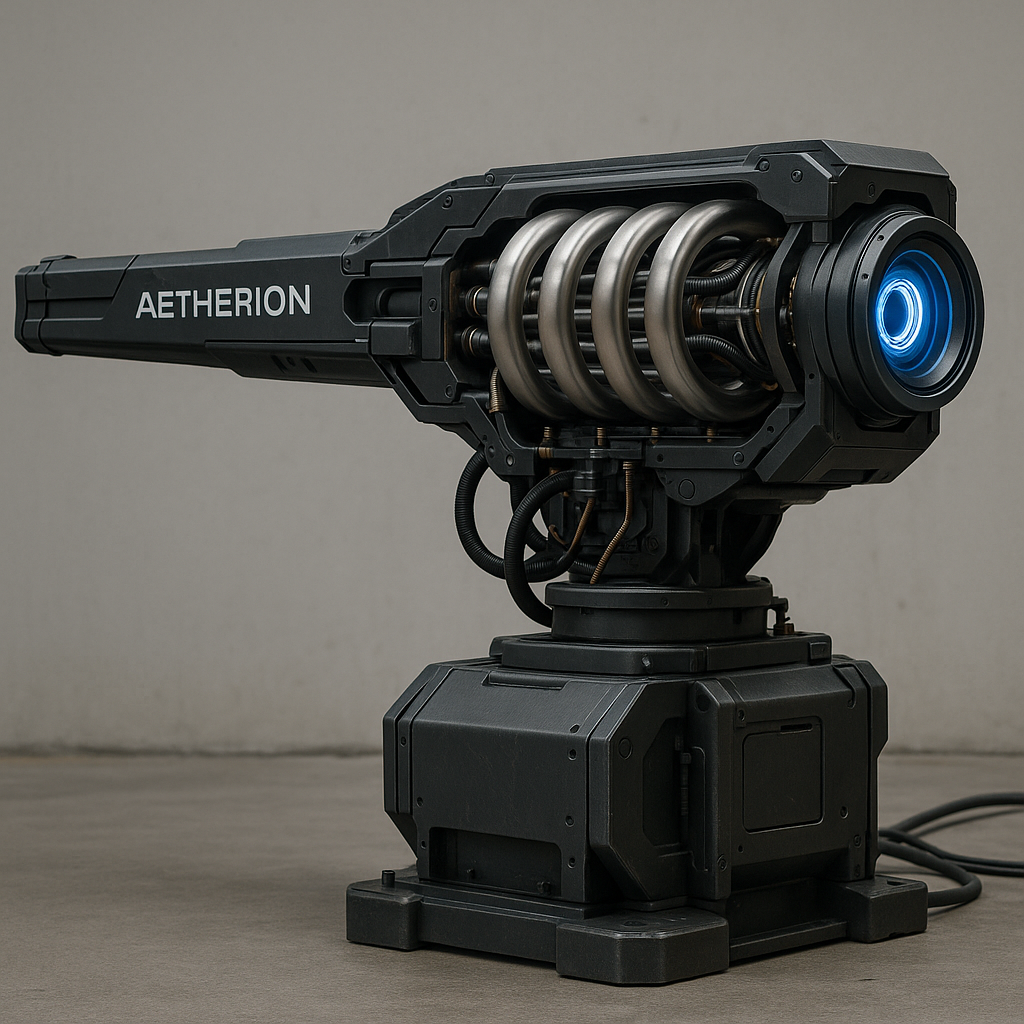
The target destination triggers the containment field to release gravitational forces, which exceed 10¹² Newtons thus causing micron-scale spaghettification and molecular bond rupture in all materials including the most durable ones. The AETHERION can penetrate 15 meters of naval-grade steel or vaporize reinforced underground bunkers because of its cutting mechanism, which produces no blast effects during operation. The weapon system relies on a deuterium-helium-3 fusion reactor to produce 600 megawatts of power output. Research into theoretical models demonstrates active gravito-inertial deflection fields and Planck-scale energy shielding as the only countermeasures effective against this weapon, yet no operational proof of such countermeasures exists.
⚜️ CHARYBDIS: Plasma Vortex Missile (PVM)
The CHARYBDIS missile uses scramjet engines and MHD flow control to provide hypersonic performance and improve energy delivery. By injecting deuterium-helium gas into a rotating plasma core and by using a pulsed magnetic confinement system, the missile creates controlled high-energy plasma vortices during the terminal phase detonation. The plasma core reaches temperatures close to 10⁷ K and obtains the best short-lived confinement by means of controlled density management, which is monitored by on-board adaptive set of algorithms that can process at petaflop speeds. A combination of onboard cryogenic cooling and yttrium barium copper oxide (YBCO) superconductors allows for the generation and support of magnetic fields up to 20 Tesla, by keeping the superconductors at ~70 K. The missile, with a hybrid scramjet-MHD propulsion scheme, accelerates from Mach 1 to Mach 7 in less than 6 seconds. With the addition of a terminal stage booster, the missile attains terminal velocities over Mach 8 (~2.7 km/s), which guarantees efficient kinetic and plasma effects with the minimum possible time-to-target. Upon impact or at detonation in close proximity, rapid compression of the plasma core by a pulsed power Z-pinch creates significant thermal and electromagnetic radiation in the surrounding area.
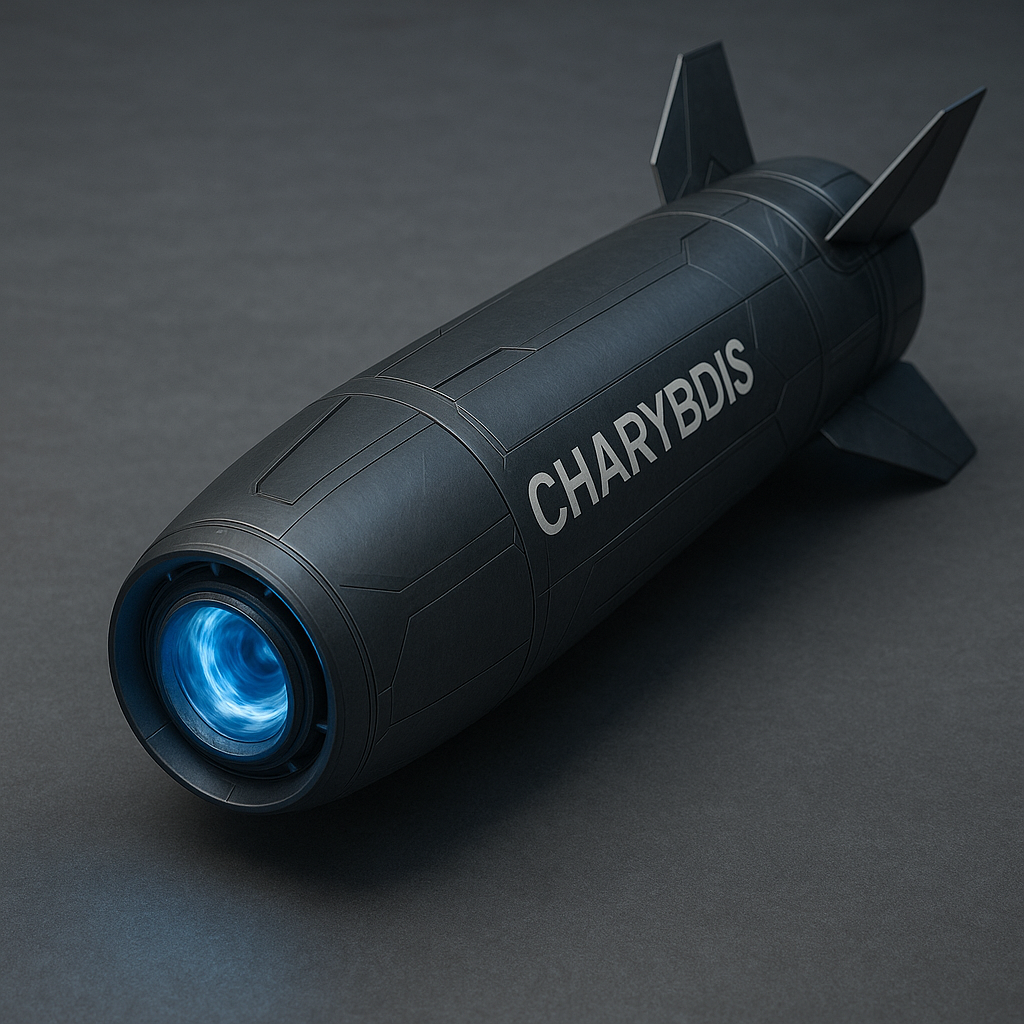
The impact discharge of energy (~10¹² W/cm²) vaporizes nearby material and triggers the generation of 300-meter radius electromagnetic disturbances. Unshielded electronic systems are disabled, and sensors are overwhelmed by signals. Able to penetrate 15 meters of naval steel or 10 meters of advanced composites, the resultant plasma vortices create thermal shear in the surrounding materials. With a radar cross-section of less than 0.001 m², the missile uses a boron nitride-based metamaterial surface designed to reflect and attenuate EM signals over a broad range of frequencies. The final phase guidance system uses lidar with inertial navigation based on quantum-optimized crystal gyroscopes to guarantee interference and spoofing resistance. Dynamic trajectory adjustment is possible with artificial intelligence, which gives an impact precision of 2 cm over a distance of 1,000 km.
⚜️ Dio-4: Hypersonic Electromagnetic Strike System
The Dio-4 Hypersonic Electromagnetic Strike System brings together multiple-scramjet power with directed-energy modules and autonomous artificial intelligence components. Dio-4 aircraft adopts a β-phase titanium-aluminide alloy with 850 MPa yield strength at 1,000°C as its foundation, while its structure incorporates woven carbon nanotube meshes having 63 GPa tension strength to fly Mach-12 at higher temperatures without failure. The weapon system uses two-stage hybrid scramjet motors, which starts with variable-thrust solid-fuel ramjets that provides 1,200s specific impulse to reach Mach 3.5 speed. The rotating detonation scramjet (RDE) system activates at this point to use plasmatron-assisted air dissociation for hypersonic cruise operations with 98% combustion efficiency and 300 kN/m² thrust density. For electromagnetic dominance Dio-4 employs multiple-mode energy projection systems. The HPM array of Dio-4 operates within 18–40 GHz frequency range with maximum output power reaching 1.2 GW to disable electronic systems. The explosively pumped flux compression generator (EPFCG) provides power through stored 1.2 MJ of energy. The FEL system functions as a free-electron laser which generates 0.85–1.5 μm wavelength radiation at 150 kW average power (500 kW burst power). The FEL system possesses M² values below 1.1 and 5 μrad divergence which enables sensor blinding at 10 km distances and rapid thermal shock effects on armor at 500 J/cm².
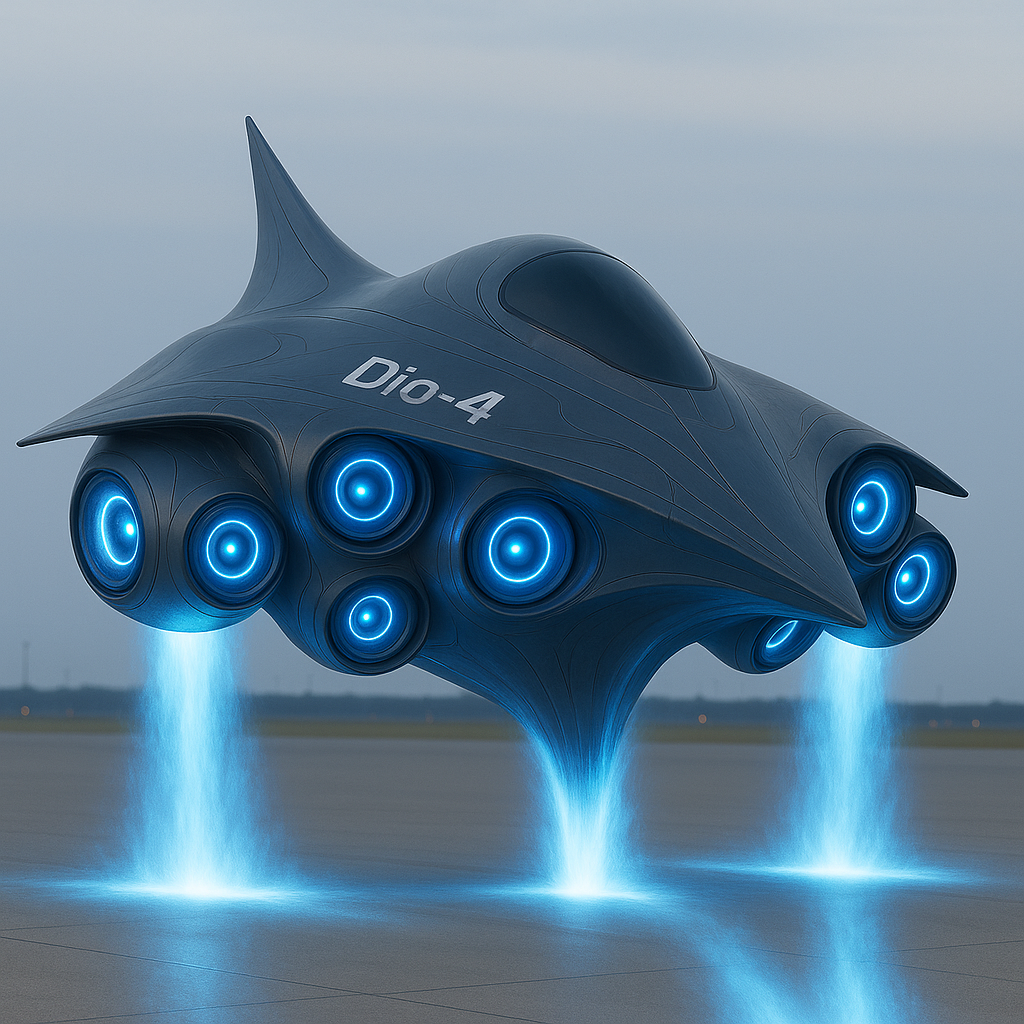
Reaction-based reinforcement learning algorithms let operators make fast trajectory choices with response times lower than 5 microsecond. Sensor fusion occurs through the combination of a quantum radar with -60 dBsm detection threshold at 94 GHz frequency and a multi-static IR/UV seeker with 512×512 HgCdTe array and 10 mK NETD and a 1,500 nm LIDAR with 1 cm ranging precision. The jet benefits from two stealth elements consisting of plasmonic metamaterial skin, which has near-zero permittivity in 3–5 μm and 8–12 μm bandwidths combined with an active plasma stealth system that generates electron densities of 10¹⁸ m⁻³ for achieving over 30 dB of RF absorption. The aircraft generates 500 kW of power from 3,500 K plasma through MHD generators with a closed-loop magnetohydrodynamic system, while regulating thermal loads reaching 1 kW/cm² heat flux. Graphene supercapacitors perform energy storage through devices with 50 Wh/kg density and 10 MW discharge rates.
⚜️ DOUREIOS: Adaptive Camouflage for Defense Systems
The advanced adaptive camouflage system Doureios enables military aircraft and naval vessels and ground vehicles to adapt visually and in infrared and radar spectra through an intelligent combined use of sensor arrays and electroactive materials and artificial intelligence-based control systems working in real-time. The system begins its operation with environmental sensing and data acquisition through multispectral sensors which include visible light cameras with RGB and hyperspectral abilities to capture terrain and background textures as well as thermal gradient monitoring through IR sensors and electromagnetic signature capturing via radar/LIDAR systems. Ambient light sensors operate to adjust the system according to different time-of-day conditions. The real-time 3D environmental map forms through the processing of data which the centralized data fusion unit receives from multiple sources. The convolutional neural network (CNN) uses AI processing to analyze sensor data for pattern selection while performing pattern generation tasks. Generative adversarial networks (GANs) optimize original textures through a process that takes less than 50 milliseconds yet enables prediction of natural surroundings which includes the modeling of aircraft banking and ocean wave pattern changes. The adaptive surface modulation functions through three main actuation systems. The visible spectrum selection happens through electrochromic polymer matrices by using thin-film conductive polymers such as polyaniline and PEDOT:PSS with a graphene electrode grid. The application of voltage triggers redox reactions in the polymer which modify its bandgap and produces reflectance spectrum changes across the 400–700 nm wavelength range through sub-millimeter pixel resolution. The second mechanism of thermal regulation in the IR spectrum relies on vanadium dioxide (VO₂). This phase-change material shows an insulating state below 70°C and a metallic state above that threshold which can be controlled through embedded microheaters. The system controls local temperatures to duplicate environmental thermal conditions thus reducing engine and body heat signatures that match backgrounds such as sky or ocean. The metamaterial radar absorber controls microwave frequencies through the combination of split-ring resonators (SRRs) and liquid crystal-based frequency-selective surfaces (FSS). The application of voltage controls liquid crystal alignment which modifies resonant frequencies from 2 to 18 GHz while using destructive interference to decrease radar cross-section (RCS).
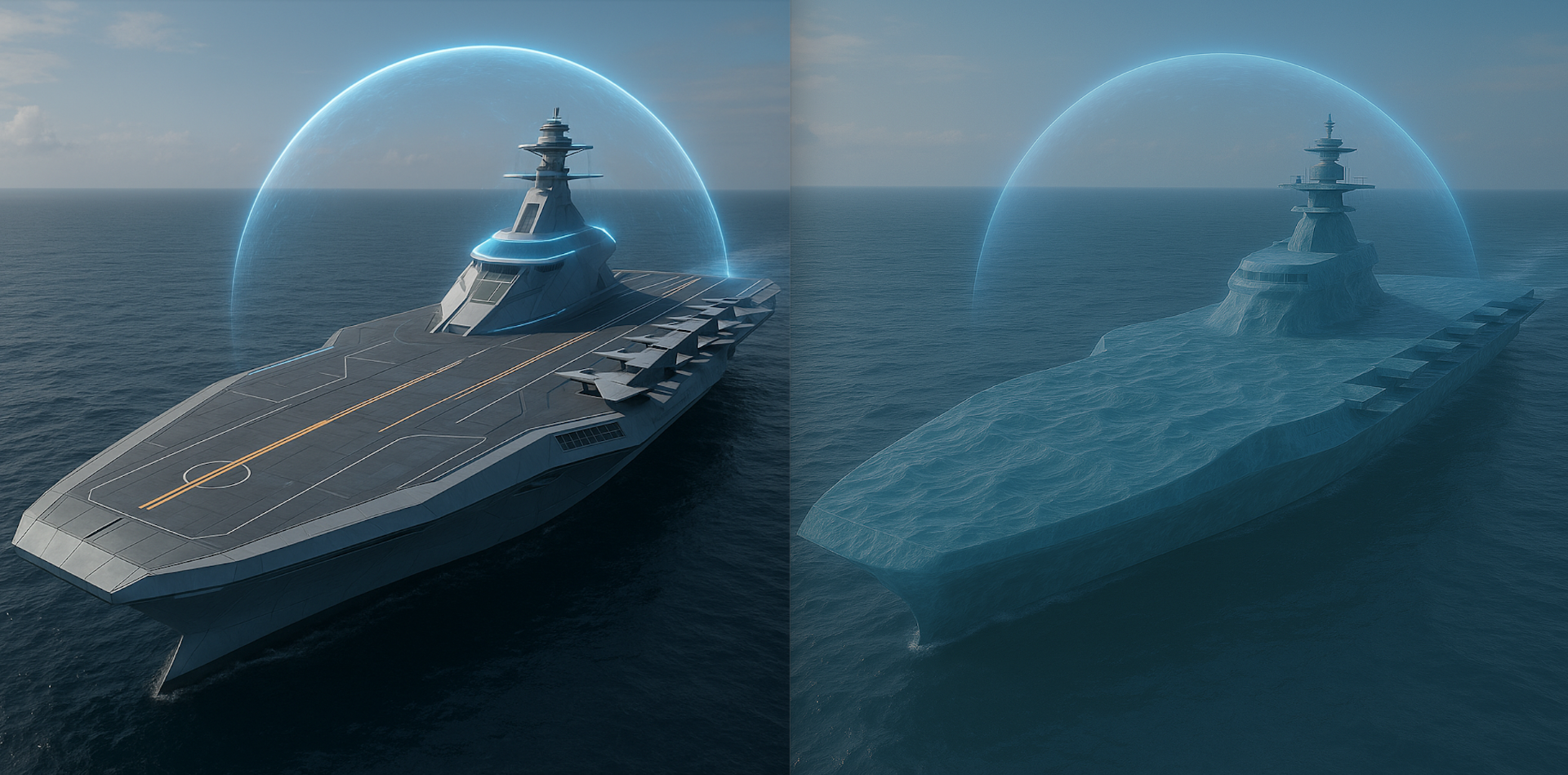
The system operates using thin-film perovskite solar cells for power generation as well as supercapacitors for electrochromic switching with high power capabilities. Vehicle systems integration requires aircraft to have defined skin surfaces and lightweights below 1.2 kg/m² as well as naval vessels with hydrophobic coatings for preventing salt corrosion while ground vehicles need modular electronic shielding along with EMI protection panels. Performance metrics show the system can achieve several capabilities including visible adaptation with 10–100 millisecond response time and 16-bit color depth, IR cloaking precision to within ±0.5°C as well as radar absorption that results in 90% reduction of RCS at X/Ku bands. The system has achieved durability through 10,000 cycles of testing which meets MIL-STD-810G standards. Doureios represents the latest development in stealth technology because it unites electrochromics with phase-change materials and metamaterials through artificial intelligence steering for automatic battlefield adaptation. The automated closed-loop structure improves platform defenses during flight and at-sea operations and while deployed on land thus establishing new performance criteria for contemporary military systems.
⚜️ HADES: Neutrino Beam Annihilator
HADES operates with directed-energy technology to generate an ultra-high-energy neutrino beam which strikes across entire planets rapidly. The core operational principle depends on creating a neutrino flux with coherent particles exceeding 10 PeV (peta-electronvolts) per particle which enables substantial interaction cross-sections with target matter despite weak-force neutrino coupling. The system operates through three main functional areas which include neutrino generation followed by beam collimation and lethal interaction induction. The production of neutrino flux occurs through a fusion reactor with quantum acceleration proton collider systems moderated by antimatter which generate 10 exajoules of energy per pulse. The secondary pion decays from a deuterium-tritium plasma under picosecond laser inertial confinement (peak pressure >10¹⁸ Pa) produce a neutrino flux density of 10³⁴ neutrinos per second while focusing the beam through a 0.1 steradian solid angle. The beam passes through a superconducting toroidal gravitic lens to create a specific 10¹⁵ T spacetime curvature gradient which neutralizes dispersion effects from the neutrinos. Quantum-entangled neutrino pairs can be used instead through a secondary "mirror" station that forces non-local interaction at the target by manipulating Bell-states at a predicted fidelity of 99.9%. The neutrino beam creates destructive effects on the target by using three main mechanisms when it reaches its destination. The cross-section of 10⁻⁴² cm² at 10 PeV allows uranium-238 nuclei to undergo photofission at 10¹² fissions per millisecond through charged-current interactions. The scattering of neutral-current with atomic electrons (with a mean free path of 1 m in iron at this energy) produces 10 MeV energy per interaction which causes immediate metallic fatigue through displacement cascades in the lattice structure.

The system benefits from three strategic advantages: it travels at lightspeed (2.5 ms Earth-crossing time), it passes through planetary magnetic fields without deflection (penetration depth >10²⁸ g/cm²) and it does not produce conventional radiation signatures. The system needs exawatt-scale power (10¹⁸ W for 1 ms pulses) which can be obtained through metastable antimatter containment (10⁶ s storage at 10¹⁵ particles/cm³) or Kerr-Newman black hole energy extraction (Hawking temperature >10²⁰ K). At present scientists confront difficulties in controlling neutrino flavor oscillations that need an accurate mass difference fine-tuning below 10⁻⁶ eV² and achieving Planck-scale gravitational lens stabilization at 10⁻³⁵ m. The Glashow resonance (6.3 PeV ν̅e + e⁻ → W⁻) serves as a detection countermeasure to reduce beam signatures and quantum cryptographic targeting algorithms employ a 10¹² qbit neural network to hash geospatial coordinates and stop backtracking. The system can be deployed either to destroy underground nuclear stockpiles with 100% ignition success at 10²⁰ ν/cm² flux or to disable spacecraft at 0.1 AU range by delivering 10⁴ Gy/s radiation damage to their avionics. Developments needed in two areas: SU(5) symmetry breaking reaching 10¹⁶ GeV and achieving 10⁸ m length scaling of neutrino entanglement. The system stands as a Class-4 existential risk according to Bostrom-Cirkovic scale and needs three redundant implementations of quantum no-cloning theorem to stop unauthorized beam duplication.
⚜️ EREBOS: Dark Matter Catalytic Warhead
The strategic weapons industry pioneered the EREBOS Dark Matter Catalytic Warhead as an innovative system using dark matter to produce directed gravitational singularities. The weapon system functions through two sequential steps that begin with dark matter collection and end with antimatter detonation to create a spacetime tear which produces extreme tactical and strategic consequences while avoiding traditional weapon side effects. The EREBOS system starts by using an advanced cryogenic quantum trap (CQT) made of superconducting niobium-tin (Nb₃Sn) coils which reach 4 Kelvin through adiabatic demagnetization. The 50 Tesla magnetic field produced by this system enables WIMPs to become polarized and captured because of their spin-dependent interactions. The system captures 10⁶ WIMPs per second within dense dark matter areas located in galactic halo regions and Lagrange points. Dark matter storage occurs through Bose-Einstein condensate stabilization of rubidium-87 atoms using lasers to achieve 10 milligrams of dark matter per warhead which equals 500 terajoules (TJ) of gravitational potential energy.

The warhead's destructive power becomes accessible through a picogram-scale antimatter initiation system. Higher than the Petawatt threshold, the 100-petawatt femtosecond laser ignites the Penning-trapped positronium plasma containing ten picograms to produce a quark-gluon plasma fireball. The stored dark matter collapses into a short-lived microsingularity which reaches a mass level of 10⁻¹⁸ kilograms (equivalent to one Planck mass) and possesses a Schwarzschild radius of 10⁻¹⁵ meters. The Hawking radiation of the singularity lasts 0.3 seconds while producing gravitational shear waves that cause total material failure of all known substances. The weapon creates spacetime curvature that reaches 10¹⁵ meters per second squared which generates destructive tidal forces able to crush high-grade naval armor throughout a 500-meter area. The weapon generates low-frequency gravitational shear waves within the 0.1–10 Hz range to maximize the destructive impact on structural materials. The weapon causes random spacetime frame-dragging effects that disrupt inertial navigation and GPS systems throughout a 20-kilometer area. The terminal guidance system of this weapon utilizes quantum-locked inertial navigation systems that protect it from electronic jamming and spoofing attempts. The weapon system employs a LIDAR array for final approach altitude selection while dark matter sensors optimize the implosion yield for maximum destructive potential. The localized gravitational singularity remains beyond the capability of any known defensive technology to either intercept or reduce its destructive effects. The warhead operates undetectably until detonation because it produces no thermal, electromagnetic or radiological signatures.
⚜️ POSEIDON: Autonomous Quantum-Hydrokinetic Battleship
POSEIDON's main design innovation includes a revolutionary Power and Propulsion System (PPS), which extends maritime capabilities. The vessel operates with a closed-cycle hydrogen combustion system, which integrates modern electrolysis technology with advanced turbine systems to reach full energy autonomy. The multi-stage proton-exchange membrane electrolyzers utilize high efficiency to convert seawater into 4,000 liters of hydrogen and oxygen per hour. The compact fusion reactor produces 150 MW of continuous output to power this process. The extracted hydrogen powers modified aeroderivative gas turbines to produce 100,000 shaft horsepower through water vapor emissions only. The superconducting magnetic containment system operates at 20K to store hydrogen reserves with daily boil-off losses at less than 0.1%, using clathrate hydrates. Marine propulsion has seen its most significant development through the quantum-enhanced hydrodynamic control system onboard the vessel. Using liquid helium to cool electromagnets into near-absolute zero allows the generation of precise Lorentz force fields that manipulate seawater at a molecular level. The system generates vortex ring propulsion which reaches high energy efficiency above conventional pump-jets, while producing adjacent low-pressure regions that lower hydrodynamic drag by 40% during cruising speed. The technology enables the generation of standing wave barriers which extend 50 meters ahead of the hull to actively protect against both collisions and incoming threats.
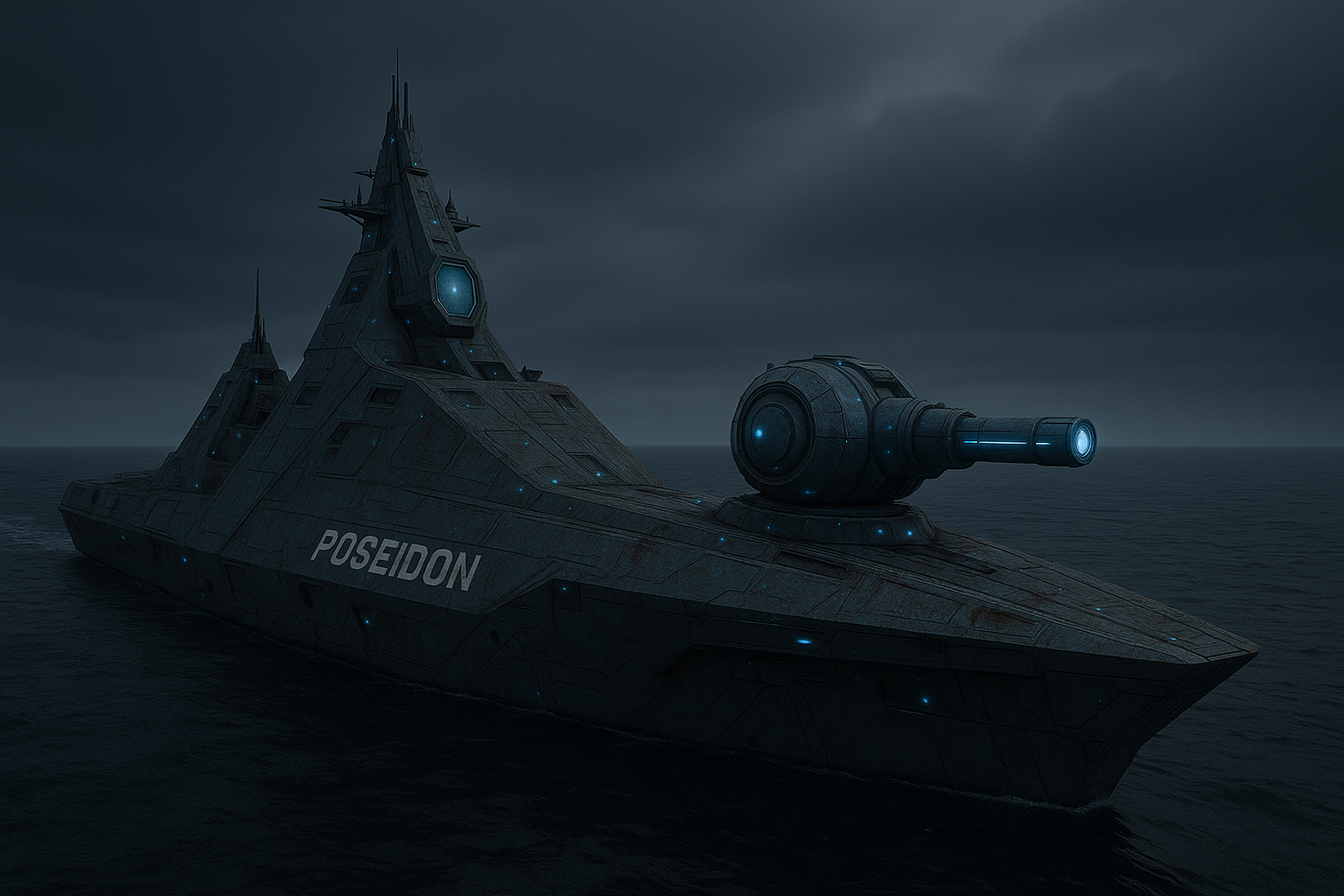
The adaptive metamaterial hull of Poseidon functions through three graded layers that operate together. Battle-damage repair happens automatically because of the exterior 10cm nanocomposite armor consists of boron nitride nanotubes embedded into shape-memory polymers. The active stealth mesh of tunable carbon metamaterials located beneath the surface allows the ship to dynamically change its radar cross-section between near-invisible 0.001 m² and deceptive 50 m² profiles. Finally, the hydrogel actuator layer at the core of the system completes the system by changing surface texture within 200 milliseconds to optimize hydrodynamic performance or achieve camouflage. A neuromorphic quantum computing core with 128-qubit processors performs 2.4 exaFLOPS real-time hydrodynamic simulations working together as a unit. The artificial nervous system operates every aspect of ship functions, while merging predictive threat assessment with high accuracy across 1,200+ parameters for controlling 200 micro-drones through millimeter-wave mesh networking. The system leverages hundreds of sensors simultaneously to gather information, which gives the AI full control over all operating domains. Poseidon has the capability to house and power an Hephaestus-Class Naval Plasma Cannon (DEW).The parametric array transducers generate 190dB low-frequency waves that extend over 18km distances, while their frequency range spans from 5Hz bone-rattling waves to 200Hz hull-resonating waves. The defensive system incorporates adaptive optic 500kW fiber lasers which provide 98% probability of intercepting Mach 5 threats. The integration of trade studies and technology roadmaps from DARPA's advanced propulsion programs (APEX), ARPA-E's fusion and hydrogen initiatives, as well as, DOE's Office of Science roadmaps on superconducting materials and ESA's quantum systems research, demonstrate the validated timelines and TRL ratings which enable a phased integration approach that proves key architectural elements feasible during a ten-year period. Poseidon vessel redefines naval supremacy in the 21st century.
⚜️ Hephaestus-Class: Naval Plasma Cannon (DEW)
The Hephaestus-Class Naval Plasma Cannon operates aboard military vessels as a directed-energy weapon (DEW) system. The plasma cannon receives its main power from the vessel's fusion reactor which needs constant 275 MW energy input to operate, while plasma forms in a toroidal chamber at 28 million Kelvin under stabilization from 22 Tesla magnetic fields generated by cryogenic niobium-tin superconducting coils. A 120-meter electromagnetic rail drives the plasma towards 0.22c (66,000 km/s) velocity through segmented high-temperature superconducting coils then propels sixty milligrams of hydrogen plasma projectile at 1.8 GJ kinetic energy till it reaches its target, while thermal energy from target material fusion reaches 750 MJ. The fire control system connects to the combat AI system through tracking sensors which include an L-band radar with 1,200 km acquisition range, X-band terminal guidance radar and quantum-locked optical sensors that compensate for atmospheric distortion with millisecond-level latency to achieve a 0.25 meter circular error probable at 600 km range. The weapon mount uses six-axis gyroscopic dampeners for active stabilization, which enables compensation of Sea State 7 wave motion and reduces recoil forces beyond 175 kN for each discharge.
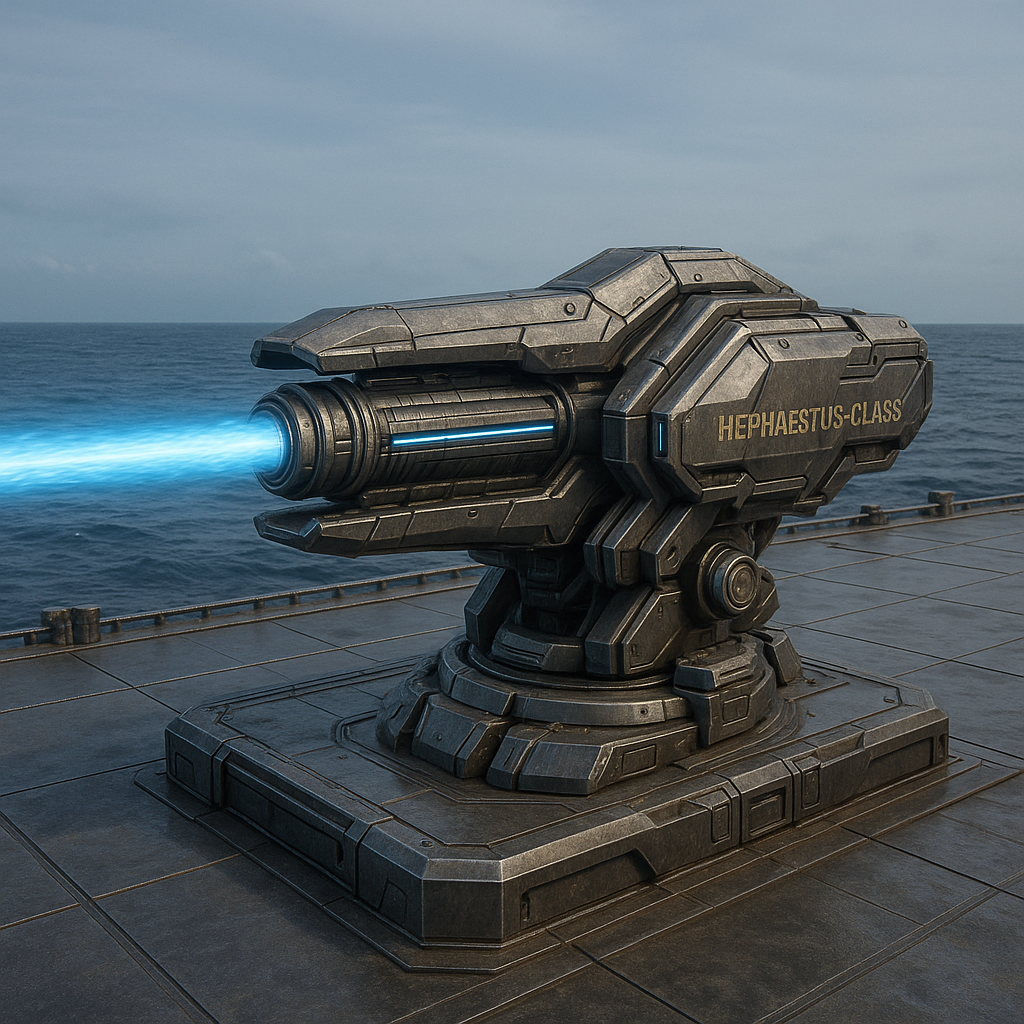
The weapon utilizes two-stage cooling through helium cryogenic superconductors operating at 4.0 K and a lithium eutectic heat exchanger that dissipates 6.2 MW of waste heat to the ship's thermal management system per discharge. The Hephaestus-Class operates at a continuous fire rate of 12 rounds per minute yet can perform bursts at 25 rounds per minute for three minutes until needing seven minutes of cooldown time before reaching its maximum 60,000 full-power discharge limit at which point tungsten-carbide barrel erosion reaches 0.5 mm tolerances. Each shot requires 1.8 kilograms of deuterium-tritium fuel that the ship obtains from its cryogenic storage tanks, which hold up to 6,000 shots and can be replenished during underway replenishment operations. The combat capabilities of this weapon allow it to penetrate 5.2 meters of naval-grade HY-100 steel armor and 2.1 meters of advanced composite armor with reactive elements. Each round creates a 250-meter diameter fireball reaching 6,500 K that neutralizes unshielded targets in the zone. The weapon fires three rounds in four (4) seconds to penetrate energy shields that have a maximum dissipation rating of 35 GJ. Operational constraints of this system involve minimum 3.0 GW reactor power requirements for vessels and thermal management needs that force tactical pauses during continuous combat operations together with a 18% effective range reduction when operating in tropical conditions with high humidity because of atmospheric plasma scattering effects. The countermeasure resistance of this system consists of two elements: frequency-agile targeting systems that resist electronic jamming and plasma projectile coherence maintained through magnetic field stabilization.
⚜️ Cloud-N: Nanobot Fog
The Cloud-N represents an advanced nanotechnological weapon platform which enables fast and accurate destruction of enemy naval vessels together with coastal installations and orbital assets. The weapon system contains trillions of microscopic nanobots that measure between 10 and 100 nanometers in diameter which remain undetectable by radar sonar or optical systems. These diamondoid-carbon lattice nanobots show outstanding protection against electromagnetic pulses (EMP), extreme temperatures (2,000°C) and corrosive conditions, which allows them to operate in aerial and marine conditions. Cloud-N delivery systems operate with flexibility because they support deployment through various methods. The nanobots disperse through the air as an aerosolized fog through stealth drones or cruise missiles or specialized artillery shells at densities between 10⁶ to 10⁸ bots per cubic centimeter. The mist particles remain undetectable because they measure less than a wavelength and generate negligible electromagnetic signals. The nanobots deployed underwater come out of submarines or torpedoes as minimum-plume formations while traveling at ocean current rates between 0.1 to 1 meter per second to enable elliptical strikes on underwater targets. The nanobots feature two energy harvesting systems which use photovoltaic cells achieving 30–40% efficiency in bright conditions together with piezoelectric or triboelectric kinetic energy harvesting in dark or underwater conditions. The electrostatic and magnetic field control system enables swarm propulsion that moves at 1–10 centimeters per second in air and 0.1–1 centimeters per second underwater. A distributed artificial intelligence system drives the swarm operations through ultra-wideband femtosecond laser communication links which work at frequencies between 1 and 10 THz. The implementation of quantum-encrypted Identify Friend/Foe (IFF) protocols allows operators to select their targets while avoiding friendly forces.
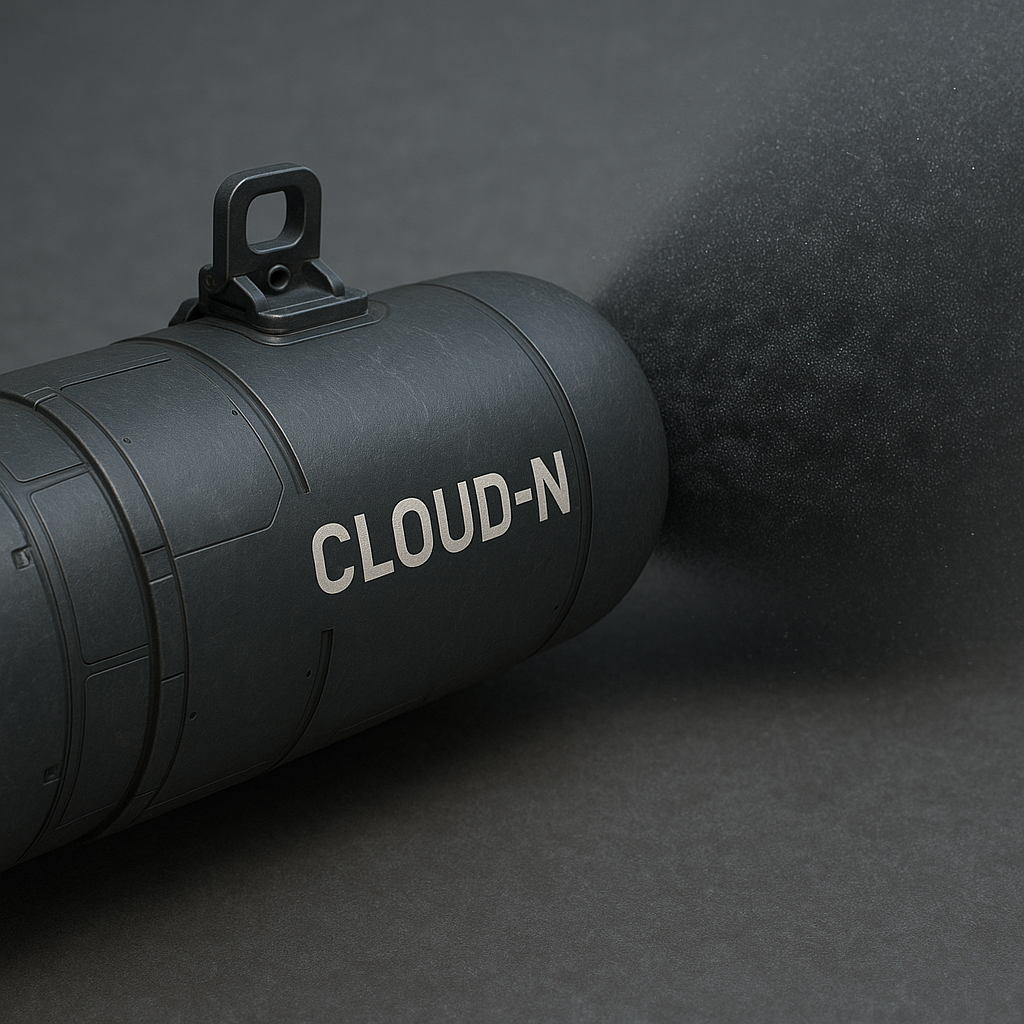
The main attacking capability of this weapon enables nanobot manipulators to sever molecular bonds of Fe-C and Al-Si metal pairs and C-C and C-H polymer pairs through forces that reach piconewton scales. Under full swarm saturation a 10,000-ton warship would sustain structural damage in under 30 minutes because its steel components dissolve at a rate of 1 kilogram per second per 10¹² nanobots. The secondary attack methods of nanobots involve electronics infiltration by breaching circuitry through sub-micron gaps to trigger short circuits via 10–100 kV electrostatic discharges or direct nanowire bridging and fuel/explosive sabotage through catalytic reactions that decompose hydrocarbons or destabilize munitions. The nanobots possess an optional self-replication mode which enables them to extract local materials such as iron, carbon, silicon etc. to assemble new units through molecular manufacturing at a rate of 10–60 minutes per cycle. The protection measures include a programmed molecular decay process (24–72 hours) and quantumencryption of replication functions to stop uncontrolled multiplication thus eliminating potential gray goo hazards. Cloud-N delivers extensive strategic benefits to its users. Its stealth properties emerge from a radar cross-section below 10⁻¹⁰ m² and acoustic absorption surpassing 99.9% which protects it from countermeasures based on CIWS, lasers or armor. The precise targeting capabilities enable operators to disable vital components without harming human personnel and its adaptable nature works against vessels ranging from small boats to aircraft carriers and submarines as well as satellites when deployed in space. A 10 kg payload has the capability to eliminate an entire carrier strike group silently within an hour while persistent nanofog operations block strategic ports and orbital deployment can destroy enemy satellites in 1–10 hours based on material composition. Cloud-N represents a revolutionary military asset which will transform naval, aerial and space combat operations during future asymmetric warfare.
⚜️ ATLANTAS: Gravitational Wave Dominance Platform
Project ATLANTAS transforming gravitational physics into warfare potential through quantum field advancements. The core system includes a toroidal array of High-Energy Superconducting Coils that generates controlled spacetime curvature inside its operational zone to produce target-gravity equivalent to Earth-gravity levels during brief operational periods. The system reaches this effect by using fast quantum vacuum state oscillations inside a helium-3 cooled chamber at 50K temperature which draws power from a small deuterium-helium-3 fusion reactor that sustains 300 megawatts of continuous output. ATLANTAS deploys its major offensive weapon system to generate precisely resonant gravitational wave pulses which operate between 0.1-100 Hz frequencies against military infrastructure targets. A pulse produces strain forces equals the strain from a magnitude 7 earthquake at one kilometer's distance and can damage reinforced concrete bunkers up to 5 kilometers through continuous microstructural breakdown. The Artificial Event Horizon (AEH) mode creates a short-lived micro-singularity of 0.1 millimeter Schwarzschild radius that lasts 3 seconds and produces over 8 million newtons of tidal force, which technically can deform a main battle tank into a 1-meter sphere.

The main defensive element comprises the Predictive Gravity Shield that shapes a spacetime curvature. The field generates enough trajectory deviation against Mach 10 hypersonic weapons that it ensures precision munitions will miss their targets at operational distances by 0.01 degrees per kilometer traveled. A full-capacity electromagnetic stealth capability from this field enables radar waves to curve around protected assets thus minimizing their radar cross-section to 0.0001 square meters. Neural Predictive Targeting serves as the cognitive center of the system integrating quantum processors with error correction on a 50-qubit system as well as neuromorphic exascale processors. Power generation and thermal management present significant engineering challenges. The primary fusion reactor needs 4 grams of deuterium-tritium fuel each hour for continuous operation and the superconducting coil array requires helium-3 loops for continuous cooling at 4 Kelvin. The system requires a 12-minute recharge between maximum-power gravitational wave pulses because thermal buildup remains the main obstacle for continuous operation. A small complex of ATLANTAS platforms operating in orbital configuration could use precise gravitational nudges to shift satellite orbits making GPS in low Earth orbit inaccessible to unshielded spacecrafts within 12 hours.
⚜️ RAVEN: Autonomous Swarm Combat System
The RAVEN model is an autonomous combat swarm using a turbofan engine to increase maneuverability and performance attributes in its design. The turbofan generates 4,900 lbf (21.8 kN) of force, while utilizing a 485 pound (220 kg) package, which features a drone-compatible design along with AI-controlled throttle systems for doing swarm operations and an infrared-reducing exhaust nozzle to minimize signatures by 60% below normal standards. The turbofan engine achieves 4,000+ hours before maintenance needs while satisfying FAA Stage 5 emission regulations for reduced observability. RAVEN drones with turbofan power units reach 600 km/h subsonic cruise speeds and can accelerate to 900 km/h for terminal attacks to provide fast response and improved defense against modern air defenses (0.5 and 0.75 Mach respectively). The drone operates at 300 km on internal fuel, but can reach 800 km with additional drop tanks installed. Its new service ceiling of 45,000 feet protects it from typical MANPADS threats.

The increased power output enables the swarm to carry 5 kg of advanced kinetic, electronic warfare or ISR packages without compromising its compact dimensions. The coordination systems operating within the swarm received an update to match its new operational performance limits. Secure data transfer between units is enabled by 10 Gbps laser communication links which work alongside MIMO radar systems that detect collisions at Mach 0.7 speeds. The upgraded AI-Maven Smart System (MSS) allows the management of 200 drones by using advanced human-machine systems. The jet propulsion system increases unit costs by €50K above the electric baseline version, yet the €85K total cost remains affordable due to added capabilities. The turbofan configuration delivers strategic advantages by allowing penetration through advanced anti-access/area denial (A2/AD) networks because of its speeds and high-altitude operational capabilities. The system is designed to work with platforms including electronic warfare systems which enables integration into European defense systems.
⚜️ DOLPHIN-X1 Amphitorp: Next-Gen Amphibious Tactical Drone
The Dolphin-X1 Amphitorp represents a state-of-the-art dual-environment autonomous AI torpedo-drone that features a bioinspired sleek design. The Amphitorp displays a dolphin-inspired fusiform shape which enables it to achieve minimal drag when operating in water and air. The stealth-coated carbon-titanium composite material makes up its exterior which features stealth capabilities and corrosion resistance. The provided design displays side and top views which reveal essential torpedo-drone characteristics. The Amphitorp exhibits dorsal as well as pectoral fin designs which support effective underwater mobility while producing lift for aerial transitions. The dorsal shell contains retractable vector-thrust micro-turbojets which provide optimal air-based propulsion functionality. This fin design duplicates marine ecosystem movements to create reduced noise emissions and turn more tightly. The ventral and rear control fins are built into the bodyline to minimize detection signatures. The AI's electro-sensory and communication nodes are symbolized by sensor pods and a glowing neural strip which runs along both sides and the top of the body. A section of the vessel contains the hybrid power system and nano-drone launch system. Through its "3-D Dolphin Maneuver" the Dolphin-X1 can make unpredictable arcs between water and air to break targeting locks. The Dolphin-X1 operates as an advanced autonomous defense platform because it utilizes real-time sensor fusion together with hull geometry that deflects sonar and countermeasures with electronic countermeasure abilities.
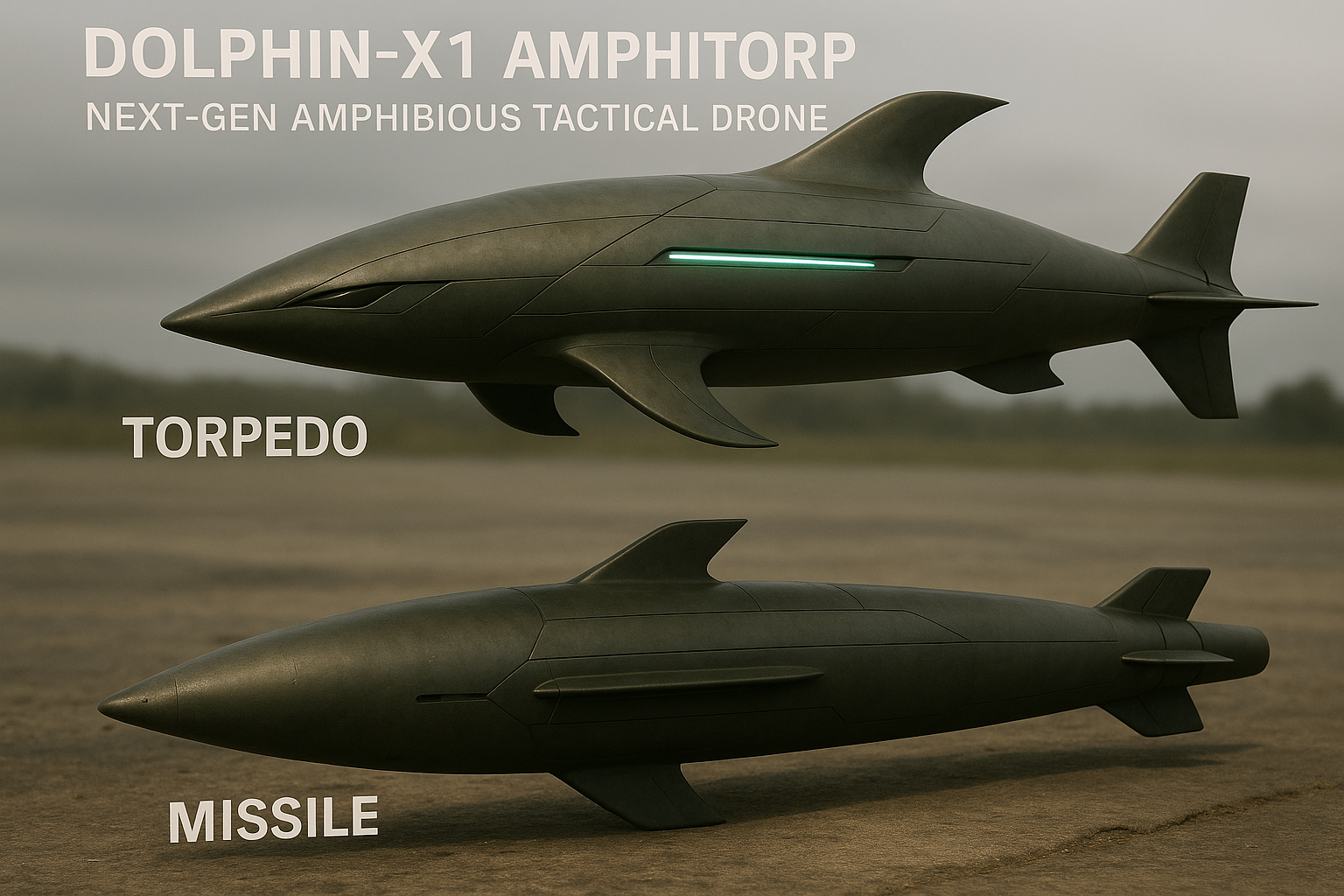
The stealth torpedo system exhibits a stealth-coated carbon-titanium composite structure with 0.85-meter width and 3.6-meter length to ensure corrosion resistance along with lightweight constructability and stealth capabilities. The 3-D Dolphin Maneuver allows the torpedo to perform unpredictable zigzag arcing movements which result in shallow aerial leaps at 15°–25° angles for 0.8–2 seconds per surfacing before submerged intervals of 1–3 seconds that can be adjusted based on depth and trajectory. Rapid changes in speed prevent enemies from maintaining their targeting systems on the target. A combination of infrared sensors and sonar enables real-time underwater threat detection and shield the system from radar and lidar surface observation while electromagnetic field detectors understandincoming projectiles and follow their departure. The units maintain synchronization through encrypted blue-green laser communication protocols to execute swarm operations together. Stealth features from the UUV depend on radar-absorbent materials (RAM) integrated with sonar-deflecting hulls which operate in combination with active counter-vibration hull nodes for noise cancellation. The defense system includes self-deploying chaff/flare drones together with optional ECM modules, which disrupt hostile tracking systems. The propulsion system uses lithium-silicon batteries for underwater movement and micro gas-turbines for explosive air bursts which are stabilized by vent flaps and gyroscopes for seamless transitions. The advanced specifications comprise an electroactive skin that changes between smooth and ribbed appearances and also include a neural AI core with a glowing sensor strip and a nano-drone swarm that functions as mid-air decoys. The system activates its autonomous recovery protocol when compromised which leads it to retreat through a low-profile underwater path.
